A Novel Approach to Integrating Community Knowledge into Fuzzy Logic-Adapted Spatial Modeling in the Analysis of Natural Resource Conflicts
Abstract
1. Introduction
- SEFLAME-CM constructs the Conflict Vulnerability Likelihood Index One and Two (CVL Index 1 and 2), adapted from [10]. The CVL Index is a measurement indicator [47] that guides NRC management towards sustainability by integrating multifaceted dimensions of drivers that had not been considered holistically by NRC management researchers.
- In a community-level case study of NRCs, SEFLAME-CM exemplifies a pragmatic application of fuzzy logic that surpasses innovative feasibility methods such as the Pythagorean fuzzy rough set or the intuitionistic approach [42,43]. SEFLAME-CM adeptly manages multiple and frequently conflicting criteria, incorporating the perceptions of conflict drivers and weighing by local stakeholders. This enhances sustainability beyond numerous applications of analogous models in other contexts [34,37,38,39,49,50,51].
- Although prior research on NRCs provides a viable framework for examining the interconnections of drivers, it does not yield an optimal resolution, as a comprehensive understanding of conflicts at their occurrence level is essential. The model presented by [45,52] considered intricate interactions with socio-economic factors yet adhered to a black-box methodology. In contrast, our model demonstrates greater flexibility by addressing micro-level uncertainty through integration.
- SEFLAME-CM transcends the fuzzification of explanatory variables, as evidenced in the study by [53]. In SEFLAME-CM, both the output and explanatory variables were fuzzified. We used fuzzy explanatory and response variables in a spatial context to develop CVL Index 2. This improved the fuzzy common vulnerability scoring system (F-CVSS), which is predicated on a least squares methodology and the fuzzy logistic regression model proposed in [53]. In our case, we examined the spatio-temporal dimensions, main driver parameters encompassing environmental, socio-economic, and political factors, as well as resource–conflict typologies. Our discussion shows great insights into NRC research at a fine-grained scale. Recent studies, possibly constrained by the constraints of machine learning techniques, have not investigated the complex links among the drivers of conflicts [45].
- Our community approach exceeds that of [36], which encountered substantial constraints on data collection owing to protected cultural locations. This differs from our approach, where we coupled stakeholders’ opinions with remotely sensed and fuzzy logic data to guide sustainability.
2. Materials and Methods
- The first step is joint problem analysis and structuring. The aim is to identify and structure the problem of NRCs within the context of a transdisciplinary coupled approach [10]. This step includes exploratory visits and measurement of biophysical components of the parameters using remote sensing. It also includes problem analysis using interviews, etc.
- The second step is modeling and simulation. As a precursor, FLAME-CM was first developed, followed by SEFLAME-CM, as stated in step 3. Refer to Section 2 for the procedures that led to the steps for the models.
- The third step was spatialization of information with geoinformation (GI) tools: here we used GIs tools to prepare the various spatial layers using state-of-the art geoinformation tools and software. Steps 2 and 3 were based on the multilevel algorithm described in Section 2.2.
- The fourth step is the integrative analysis step: we visualized the results from step three and prepared the data for model comparison with previous methods.
- In the fifth step, we compared our model with previously used models. This was based on the following: First, we conducted a time scale validation. Here we looked at the vulnerability dimensions as different conditions that could influence the occurrence of NRCs. Second, we compared the two types of NRCs studied with the three dimensions. Third, we compared the result of the model SEFLAME-CM with existing models. The results of the fifth step informed the analysis results presented in the Section 4.
- Finally, we proposed the evaluation of possible scenarios, a necessary step that future researchers could take up.
2.1. Materials for Spatial Acquisition, Procedures, and Justification of the Selection of NRC Factors
- The UCDP Dataset—(refer to the Uppsala Conflict Data Programme (UCDP) on the website: https://www.ucdp.uu.se/downloads/, accessed 1 January 2016.
- The ACLED Dataset—(refer to Armed Conflict Location Event Data (ACLED) on the website: https://www.acleddata.com/data/, accessed on 1 January 2016) [10,73] and to [73] for a discussion of the two types of NRCs.
2.1.1. Data from Secondary Sources
2.1.2. Workshops, Surveys, and Local Knowledge on Perception of Conflicts
2.1.3. Remote Sensing for Deriving Environmental Parameters
2.2. Model
2.2.1. Qualitative and Quantitative Data Integration Procedures
2.2.2. Model Variables and Implementation Procedures
- Layer 1:
- Deriving the initial input parameters based on weights from the actors.
- Layer 2:
- Integrating the model input parameters.
- Layer 3:
- Target variables (Y): The rebel conflicts (RBC) and territorial conflicts (TBC).
- Layer 4:
- The CVL Index 1 and the CVL Index 2.
2.2.3. Membership Functions (MFs) and Evaluation
2.2.4. The Process of Creating Fuzzy Rules by Combining Expert Knowledge with Linguistics Statements from Interviews
2.2.5. Fuzzy Implication Rules
2.2.6. The OR and/or AND Fuzzy Operators
2.2.7. Aggregation of Outputs
2.2.8. Making Decisions Using Defuzzification (Centroid Defuzzification Algorithm)
2.2.9. Model Comparison with Previous Models
2.3. Description of FUZZYCONDATA and Spatial Attributes
2.4. Case Study
2.4.1. Spatial Attributes of the Test Case
2.4.2. Research-Based Conflict Resolution Techniques and Development Policies of the Study Region
3. Results
3.1. Graphical Representation of SEFAME-CM
3.2. Results of the Fufzzy Operator and Fuzzy Rules
3.3. Aggregated Outputs
3.4. Results of Comparison with a Previous Model
4. Discussion
4.1. Implications of Spatio-Temporal Distribution of NRCs: Ogoni (Inland) and Okrika (Coastland)
- Rebel NRCs (Inland): For the rebel type of NRCs in Ogoni, the spatial CVL Index is projected to be 0% for both the 1986–2000 and 2000–2016 periods. The index experienced a decline from a probability of 12%, classified as very likely, during the period from 1986 to 2000, to 55%, classified as very likely, in the subsequent period from 2000 to 2016. As expected, the index experienced a decline from 55% during the period of 1986–2000, decreasing to 33% in the subsequent period from 2000 to 2016.
- Territorial NRCs (Inland): The dynamics of NRCs in Ogoni are most significant in instances of territorial disputes. The spatial CVL Index is estimated to have risen from most likely (0%) during the period of 1986–2000 to 33% in 2000–2016. Moreover, the index rose from very likely (39%) to 47% during the periods of 1986–2000 and 2000–2016, respectively. In contrast to rebel NRCs in Ogoni, the issues concerning land resources and territorial claims hold greater significance than uprisings and youthful aggression [91].
- All NRCs (Inland): In Ogoni, the index recorded a most likely value of 3% during the period from 1986 to 2000, and a value of 0% from 2000 to 2016. Recent years have shown a noticeable reduction in conflicts within the inland regions, especially in the Ogoni territory. A notable trend of conflict diffusion from inland areas to coastal regions has been observed over time. Initial investigations into NRCs have primarily focused on the initiation and length of conflicts and resource-related conflicts throughout history [5]. The study was unable to elucidate the factors contributing to the reduction and dispersion of conflicts across various regions without conducting an analysis or measurement of conflicts at the sub-national level [15,100].
- Rebel NRCs on the Coast: The index was most likely (49%) in Okrika for the period of 1986 to 2000. Within the period from 2000 to 2016, the percentage increased to 65%. Between the two-year periods of our investigation, the spatial index was very likely and reduced from 17% to 1%. In addition, the index fell under the likely category but dropped from 30% to 0% across the two periods.
- Territorial NRCs on the Coast: The index of the 1986 to 2000 period was most likely (33%) in Okrika. This saw a slight increase to 34% within 2000 to 2016. A comparative analysis of the Ogoni area (inland) reveals that the coastland exhibits a higher susceptibility to resource conflicts concerning telluric resources [101]. This suggests a significant likelihood of heightened territorial disputes in the future, particularly in coastal regions.
- All NRCs on the Coast: In Okrika, the index score fell within the most likely category. This almost doubled from (16%) from 1986 to 2000 to 30% in the 2000–2016 era. The most likely category’s spatial CVL index rose from 48% between 1986 and 2000 to 60% between 2000 and 2016. The findings suggest a spread of conflicts from the inland (Ogoni) to the coastal zone.
4.2. Implications of Types of NRCs vs. All the Driver Dimension
4.3. SEFLAME-CM and Comparison with SMCE-CM
4.4. Implications of SEFLAME-CM and the Novel Applications of Fuzzy Logic Modeling
5. Limitations
6. Conclusions
Author Contributions
Funding
Institutional Review Board Statement
Informed Consent Statement
Data Availability Statement
Acknowledgments
Conflicts of Interest
Appendix A
Appendix A.1. The CVL Index—Environmental Drivers of Conflicts vs. Rebel-Based Conflicts (YIevRBC)
Appendix A.2. The CVL Index for All Rebel-Based Conflict Typology (YIRB)
Appendix A.3. The Final CVL Index Based on FLAME-CM (Non-Spatially Explicit) (CVL Index)
Appendix B
Appendix B.1. Sample IF THEN RULES: Environmental Dimension
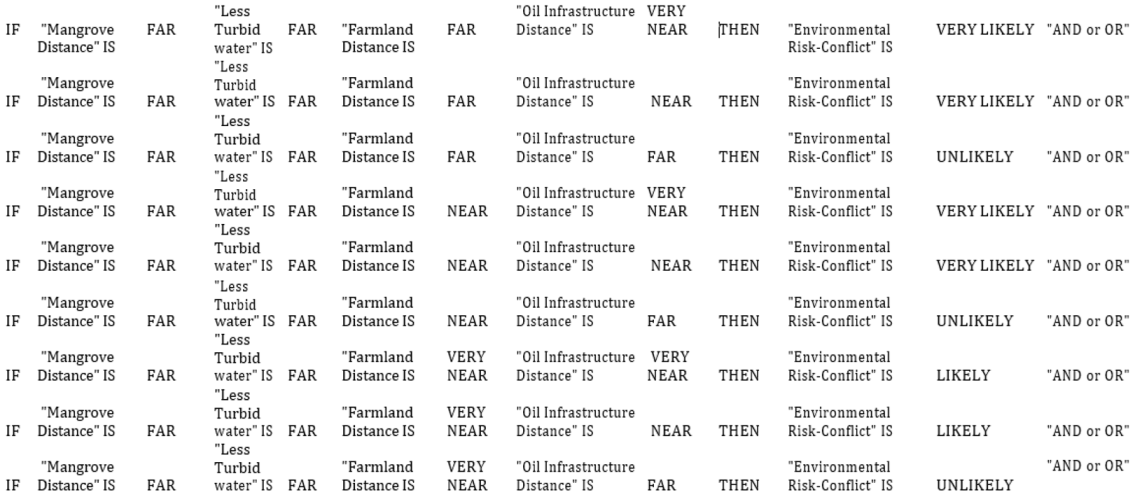
Appendix B.2. Sample IF THEN RULES: Socio-Economic Dimension
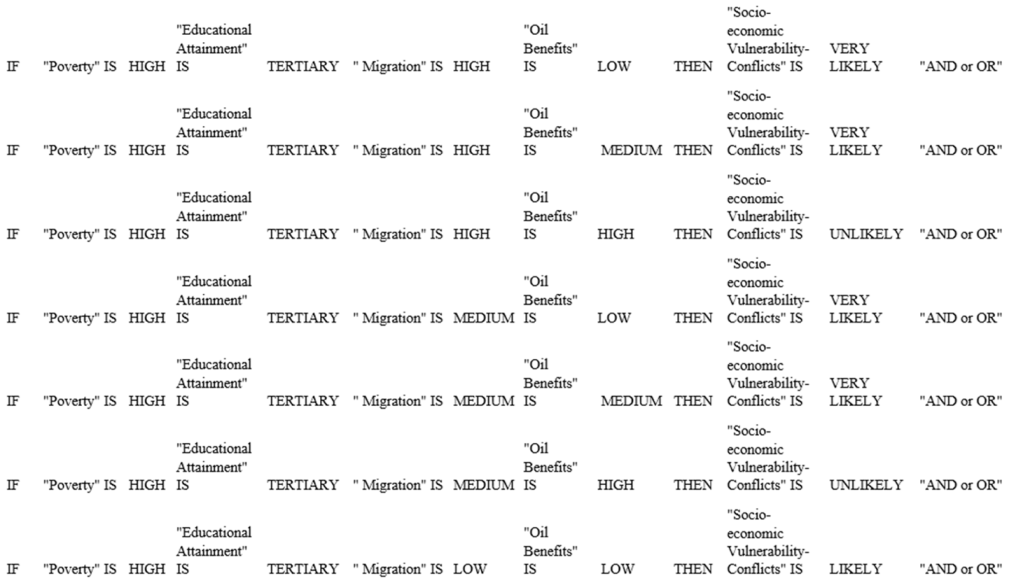
Appendix B.3. Sample IF THEN RULES: Political Dimension
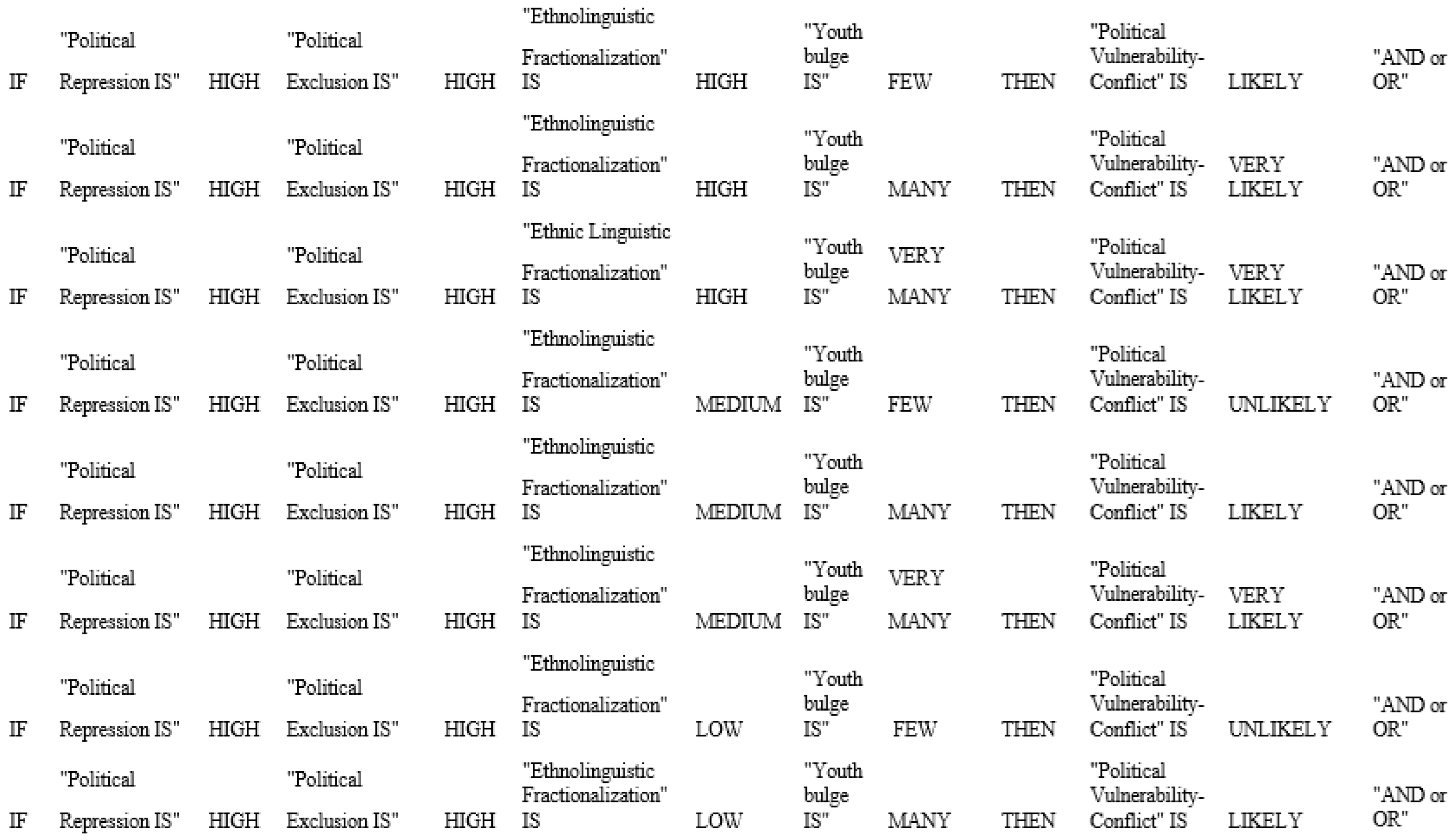
Appendix C
Appendix C.1. Fuzzy Maps of Environmental Drivers and Parameters of NRCs, 1986–2000
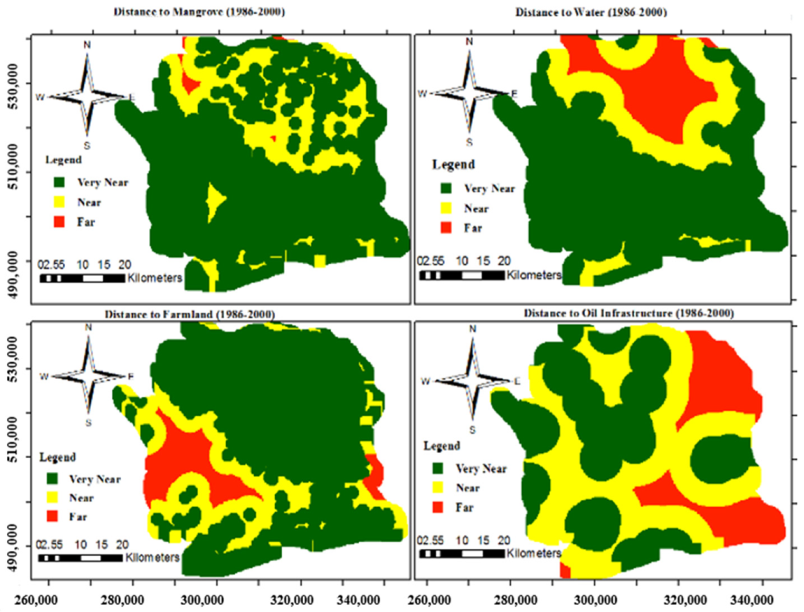
Appendix C.2. Fuzzy Maps of Socio-Economic Drivers and Parameters of NRCs, 1986–2000
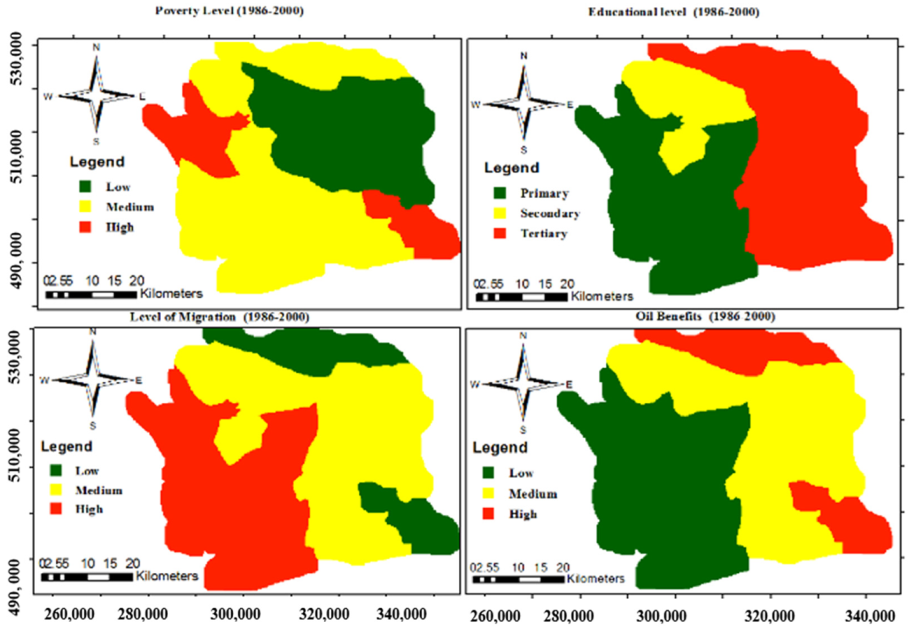
Appendix C.3. Maps of Political Drivers and Parameters of NRCs, 1986–2000

Appendix D
Appendix D.1. Fuzzy Maps of Environmental Drivers and Parameters of NRCs, 2000–2016
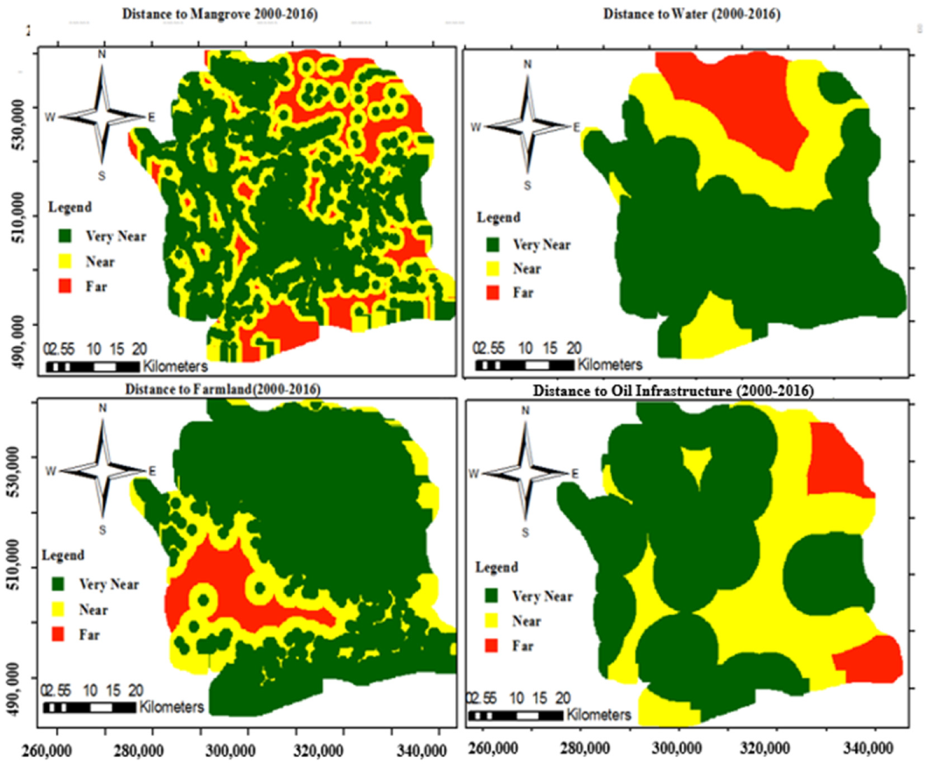
Appendix D.2. Maps of Socio-Economic Drivers and Parameters of NRCs, 2000–2016

Appendix D.3. Maps of Political Drivers and Parameters of NRCs 2000–2016
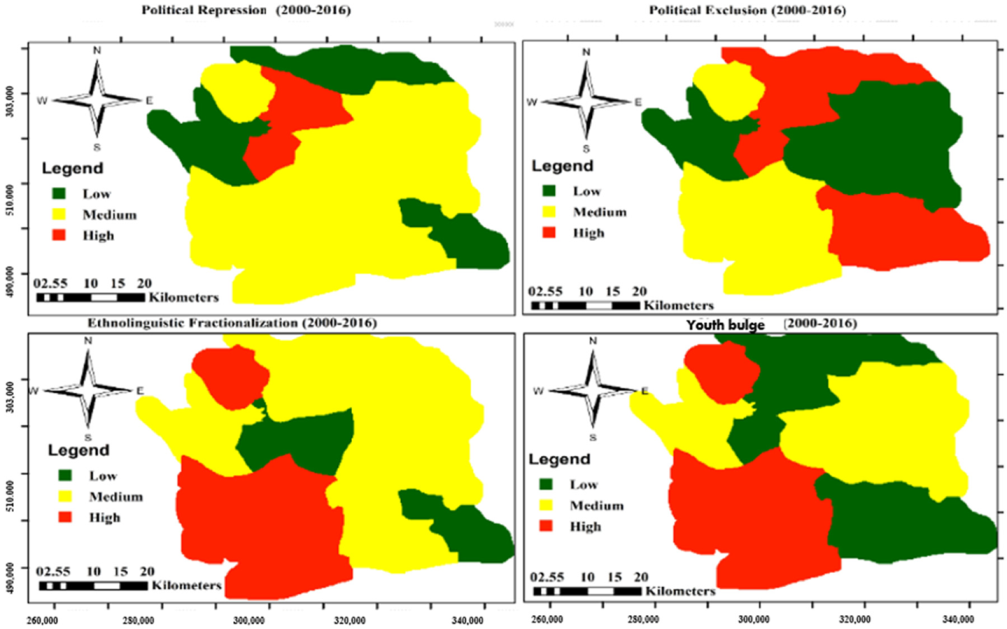
Appendix E
Appendix E.1. Spatial Conflict Clusters: SEFLAME-CM and SMCE-CM, 1986–2000
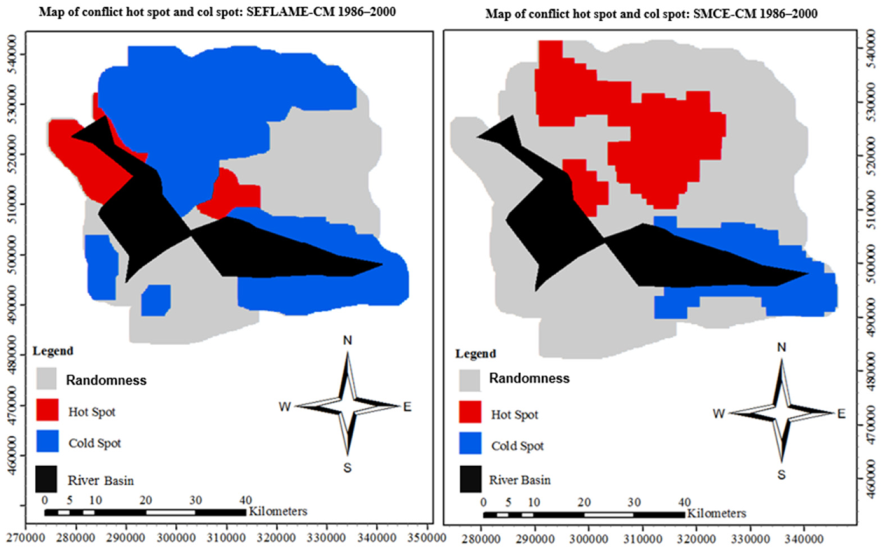
Appendix E.2. Spatial Conflict Clusters: SEFLAME-CM and SMCE-CM, 2000–2016
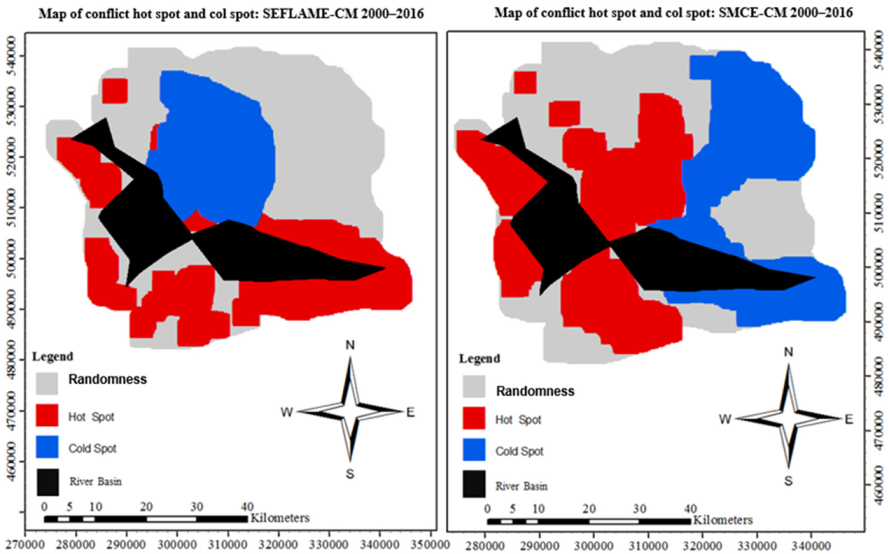
References
- UNEP. Toolkit and Guidance for Preventing and Managing Land and Natural Resources Conflict; UNEP: Nairobi, Kenya, 2012. [Google Scholar]
- UNEP. UNEP Post 2015 Note: Environmental Dmensions of Resilient and Peaceful Societies. 2015. Available online: https://wedocs.unep.org/handle/20.500.11822/9674?show=full (accessed on 21 September 2023).
- Hoeffler, A.; Collier, P.; Rohner, D. Beyond Greed and Grievance: Feasibility and Civil War. Oxf. Econ. Pap. 2009, 61, 1–27. [Google Scholar] [CrossRef]
- Collier, P.; Hoeffler, A. High-value natural resources, development, and conflict: Channels of causation. In High-Value Natural Resources and Peacebuilding; Routledge: London, UK, 2012. [Google Scholar]
- Collier, P.; Hoeffler, A. Greed and Grievance in Civil War. Oxf. Econ. Pap. 2004, 56, 563–595. [Google Scholar] [CrossRef]
- Collier, P.; Hoeffler, A. On Economic Causes of Civil Wars. Oxf. Econ. Pap. 1998, 50, 563–573. [Google Scholar] [CrossRef]
- Homer-Dixon, T.; Boutwell, J.; Rathjens, G. Environmental Change and Violent Conflict. Sci. Am. 2011, 268, 18–25. [Google Scholar] [CrossRef]
- Homer-Dixon, T.; Levy, M. Environment and Security. Int. Secur. 1995, 20, 189–198. [Google Scholar] [CrossRef]
- Ostrom, E.; Burger, J.; Field, C.B.; Norgaard, R.B.; Policansky, D. Revisiting the commons: Local lessons, global challenges. Am. Assoc. Adv. Sci. 1999, 284, 278–282. [Google Scholar] [CrossRef]
- Ibeh, L. A Transdisciplinary-Based Coupled Approach for Vulnerability Assessment in the Context of Natural Resource-Based Conflicts Using Remote Sensing, Spatial Statistics and Fuzzy Logic Adapted Models. Ph.D. Thesis, LMU, München, Germany, 2019. Available online: https://edoc.ub.uni-muenchen.de/24770/1/Ibeh_Lawrence.pdf (accessed on 1 January 2024).
- Fearon, J. Primary Commodity Exports and Civil War. J. Confl. Resolut. 2005, 49, 483–507. [Google Scholar] [CrossRef]
- Brauch, H. Building Sustainable Peace by Moving Towards Sustainability Transition. In Addressing Global Environmental Challenges from a Peace Ecology Perspective; Springer: Cham, Switzerland, 2016; Volume 4, pp. 145–179. [Google Scholar] [CrossRef]
- Brauch, H.; Spring, Ú.O.; Mesjasz, C.; Grin, J.; Kameri-Mbote, P.; Chourou, B.; Dunay, P.; Birkmann, J. Coping with Global Environmental Change, Disasters and Security: Threats, Challenges, Vulnerabilities and Risks; Springer Science & Business Media: Berlin/Heidelberg, Germany, 2011. [Google Scholar] [CrossRef]
- Brauch, H. Sustainable Peace in the Anthropocene: Towards Political Geoecology and Peace Ecology. In Handbook on Sustainability Transition and Sustainable Peace; Springer: Cham, Switzerland, 2016; Volume 10, pp. 187–236. [Google Scholar] [CrossRef]
- Buhaug, H.; Lujala, P. Measuring Geography in Quantitative Studies of Civil War. Polit. Geogr. 2005, 24, 399–418. [Google Scholar] [CrossRef]
- Bernauer, T.; Gleditsch, N. New Event Data in Conflict Research. Int. Interact. 2012, 38, 375–381. [Google Scholar] [CrossRef]
- Johansson, P. Nurturing Adaptive Peace: Resilience Thinking for Peacebuilders. In Proceedings of the Fifteenth Biennial Conference of the International Association for the Study of the Commons, Mumbai Region, India, 27 May 2015; pp. 2–15. Available online: https://dlc.dlib.indiana.edu/dlc/bitstream/handle/10535/9838/Johansson_Patrik_Adaptive_Peace_May15.pdf?sequence=1&isAllowed=y (accessed on 21 September 2023).
- Ratner, B.; Meinzen-Dick, R.; May, C.; Haglund, E. Resource Conflict, Collective Action, and Resilience: An Analytical Framework. Int. J. Commons 2013, 7. [Google Scholar] [CrossRef]
- Sivakumar, B. Water Crisis: From Conflict to Cooperation. An Overview. Hydrol. Sci. J. 2011, 56, 531–552. [Google Scholar] [CrossRef]
- Ekong, F.; Atser, J.; Ebong, S. Water Resource Management in the Niger Delta Region of Nigeria: The Role of Physical Planning. Int. Rev. Soc. Sci. Humanit. 2012, 3, 51–61. [Google Scholar]
- Gray, S.; Chan, A.; Clark, D.; Jordan, R. Modeling the integration of stakeholder knowledge in social–ecological decision-making: Benefits and limitations to knowledge diversity. Ecol. Model. 2011, 229, 88–96. [Google Scholar] [CrossRef]
- Okpara, U.; Stringer, L.; Dougill, A. Using a novel climate–water conflict vulnerability index to capture double exposures in Lake Chad. Reg. Environ. Chang. 2017, 17, 351–366. [Google Scholar] [CrossRef]
- Fountis, A.; Arunachalam, V. Creating A Sustainable Development Model for the Trading of Industrial Minerals. J. Contemp. Issues Bus. Gov. 2021, 27, 1557–1567. [Google Scholar] [CrossRef]
- Mauser, W.; Klepper, G.; Rice, M.; Schmalzbauer, B.S.; Hackmann, H.; Leemans, R.; Moore, H. Transdisciplinary global change research: The co-creation of knowledge for sustainability. Curr. Opin. Environ. Sustain. 2013, 5, 420–431. [Google Scholar] [CrossRef]
- Woodall, L.C.; Talma, S.; Steeds, O.; Stefanoudis, P.; Jeremie-Muzungaile, M.M.; De Comarmond, A. Co-development, co-production and co-dissemination of scientific research: A case study to demonstrate mutual benefits. Biol. Lett. 2021, 17, 20200699. [Google Scholar] [CrossRef]
- Rustad, S.; Binningsbø, H. A Price Worth Fighting For? Natural Resources and Conflict Recurrence. J. Peace Res. 2012, 49, 531–546. [Google Scholar] [CrossRef]
- Buhaug, H.; Gleditsch, K. Contagion or Confusion? Why Conflicts Cluster in Space. Int. Stud. Q. 2008, 52, 215–233. [Google Scholar] [CrossRef]
- Zadeh, L. From Computing with Numbers to Computing with Words—From Manipulation of Measurements to Manipulation of Perceptions. In Logic, Thought and Action; Springer: Dordrecht, The Netherlands, 2005; Volume 12, pp. 507–544. [Google Scholar] [CrossRef]
- Zadeh, L. A New Direction in AI: Toward a Computational Theory of Perceptions. AI Mag. 2001, 22, 628. [Google Scholar] [CrossRef]
- Agrawal, A.; Ostrom, E. Collective Action, Property Rights, and Decentralization in Resource Use in India and Nepal. Politics Soc. 2001, 29, 485–514. [Google Scholar] [CrossRef]
- Ostrom, E. A general framework for analyzing sustainability of social-ecological systems. Science (1979) 2009, 325, 419–422. [Google Scholar] [CrossRef] [PubMed]
- Kamran, M.; Ismail, R.; Al-Sabri, E.H.A.; Salamat, N.; Farman, M.; Ashraf, S. An Optimization Strategy for MADM Framework with Confidence Level Aggregation Operators under Probabilistic Neutrosophic Hesitant Fuzzy Rough Environment. Symmetry 2023, 15, 578. [Google Scholar] [CrossRef]
- Kamran, M.; Ashraf, S.; Naeem, M. A promising approach for decision modeling with single-valued neutrosophic probabilistic hesitant fuzzy dombi operators. Yugosl. J. Oper. Res. 2023, 33, 549–575. [Google Scholar] [CrossRef]
- Rodríguez-Pérez, Á.M.; Rodríguez, C.A.; Márquez-Rodríguez, A.; Mancera, J.J.C. Viability Analysis of Tidal Turbine Installation Using Fuzzy Logic: Case Study and Design Considerations. Axioms 2023, 12, 778. [Google Scholar] [CrossRef]
- Kambalimath, S.; Deka, P.C. Applications of Fuzzy Logics in Modern Systems: A Simple Survey. Int. J. Res. Publ. Rev. 2024, 5, 7598–7600. [Google Scholar] [CrossRef]
- Pérez, Á.M.R.; Rodríguez, C.A.; Rodríguez, L.O.; Mancera, J.J.C. Revitalizing the Canal de Castilla: A Community Approach to Sustainable Hydropower Assessed through Fuzzy Logic. Appl. Sci. 2024, 14, 1828. [Google Scholar] [CrossRef]
- Kamran, M.; Ashraf, S.; Salamat, N.; Naeem, M.; Hameed, M.S. Smart city design plan selection through single-valued neutrosophic probabilistic hesitant fuzzy rough aggregation information. J. Intell. Fuzzy Syst. 2023, 45, 10693–10737. [Google Scholar] [CrossRef]
- Niswati, Z.; Mustika, F.A.; Paramita, A. Fuzzy logic implementation for diagnosis of Diabetes Mellitus disease at Puskesmas in East Jakarta. J. Phys. Conf. Ser. 2018, 1114, 012107. [Google Scholar] [CrossRef]
- Minli, Z.; Wenpo, Y. Fuzzy Comprehensive Evaluation Method Applied in the Real Estate Investment Risks Research. Phys. Procedia 2012, 24, 1815–1821. [Google Scholar] [CrossRef]
- Yao, Y. Three-way conflict analysis: Reformulations and extensions of the Pawlak model. Knowl. Based Syst. 2019, 180, 26–37. [Google Scholar] [CrossRef]
- Zhi, H.; Li, J.; Li, Y. Multilevel Conflict Analysis Based on Fuzzy Formal Contexts. IEEE Trans. Fuzzy Syst. 2022, 30, 5128–5142. [Google Scholar] [CrossRef]
- Zhao, J.; Wan, R.; Miao, D. Conflict Analysis Triggered by Three-Way Decision and Pythagorean Fuzzy Rough Set. Int. J. Comput. Intell. Syst. 2024, 17, 1–25. [Google Scholar] [CrossRef]
- Du, J.; Liu, S.; Liu, Y.; Yi, J. A novel approach to three-way conflict analysis and resolution with Pythagorean fuzzy information. Inf. Sci. 2022, 584, 65–88. [Google Scholar] [CrossRef]
- Pawlak, Z. Some remarks on conflict analysis. Eur. J. Oper. Res. 2005, 166, 649–654. [Google Scholar] [CrossRef]
- Schellens, M.K.; Belyazid, S. Revisiting the contested role of natural resources in violent conflict risk through machine learning. Sustainability 2020, 12, 6574. [Google Scholar] [CrossRef]
- Cimino, A.; Cimino, A.; Oieni, A. Fuzzy Logic Implementation of Vulnerability Assessment in a Coastal Aquifer of Northern Sicily. J. Geosci. Environ. Prot. 2021, 9, 177–188. [Google Scholar] [CrossRef]
- Liu, Z. Article citation contribution indicator: Application in energy and environment. Ecofem. Clim. Chang. 2022, 3, 81–84. [Google Scholar] [CrossRef]
- Kienberger, S.; Blaschke, T.; Zaidi, R.Z. A framework for spatio-temporal scales and concepts from different disciplines: The ‘vulnerability cube’. Nat. Hazards 2013, 68, 1343–1369. [Google Scholar] [CrossRef]
- Kamran, M.; Abdalla, M.E.M.; Nadeem, M.; Uzair, A.; Farman, M.; Ragoub, L.; Cangul, I.N. A Systematic Formulation into Neutrosophic Z Methodologies for Symmetrical and Asymmetrical Transportation Problem Challenges. Symmetry 2024, 16, 615. [Google Scholar] [CrossRef]
- Liu, Z.; Ge, B.; Huang, Y.; Hou, Z.; Wei, W.; Xie, H. Fuzzy-based dilemma assessment in confrontation analysis with applications to the Walkerton Drinking Water Crisis. Appl. Soft Comput. 2024, 162, 111793. [Google Scholar] [CrossRef]
- Zhang, W.; Li, B.; Liu, Z.; Zhang, B. Application of improved fuzzy comprehensive evaluation method in karst groundwater quality evaluation: A case study of Cengong county. Earth Sci. Inf. 2021, 14, 1101–1109. [Google Scholar] [CrossRef]
- Liu, J.; Liu, W.; Allechy, F.B.; Zheng, Z.; Liu, R.; Kouadio, K.L. Machine learning-based techniques for land subsidence simulation in an urban area. J. Environ. Manag. 2024, 352, 120078. [Google Scholar] [CrossRef] [PubMed]
- Gencer, K.; Başçiftçi, F. The fuzzy common vulnerability scoring system (F-CVSS) based on a least squares approach with fuzzy logistic regression. Egypt. Inform. J. 2021, 22, 145–153. [Google Scholar] [CrossRef]
- Ncube, M.M.; Ngulube, P. Enhancing environmental decision-making: A systematic review of data analytics applications in monitoring and management. Discov. Sustain. 2024, 5, 290. [Google Scholar] [CrossRef]
- Obiedat, M.; Samarasinghe, S. Modelling Socio-ecological Systems: Implementation of an Advanced Fuzzy Cognitive Map Framework for Policy development for addressing complex real-life challenges. arXiv 2022, arXiv:2208.05103. [Google Scholar]
- Hauge, W.I.; Ellingsen, T. Causal Pathways to Conflict. 2018. Available online: https://api.semanticscholar.org/CorpusID:158790657 (accessed on 12 December 2022).
- Tollefsen, A.F.; Buhaug, H. Insurgency and inaccessibility. Int. Stud. Rev. 2015, 17, 6–25. [Google Scholar] [CrossRef]
- Kalbhenn, A. Democracy, International Interlinkages and Cooperation over Shared Resources. Ph.D. Thesis, ETH, Zurich, Switzerland, 2010. [Google Scholar] [CrossRef]
- Lujala, P.; Rød, J.K.; Thieme, N. Fighting Over Oil: Introducing a New Dataset. Confl. Manag. Peace Sci. 2007, 24, 239–256. [Google Scholar] [CrossRef]
- Buhaug, H.; Rød, J.K. Local determinants of African civil wars, 1970–2001. Polit Geogr. 2006, 25, 315–335. [Google Scholar] [CrossRef]
- Hegre, H.; Østby, G.; Raleigh, C. Poverty and Civil War Events: A Disaggregated Study of Liberia. J. Confl. Resolut. 2009, 53, 598–623. [Google Scholar] [CrossRef]
- Barakat, B.; Urdal, H. Breaking the Waves? Does Education Mediate the Relationship Between Youth Bulges and Political Violence? 2009. Available online: https://documents.worldbank.org/en/publication/documents-reports/documentdetail/403881468165872383/breaking-the-waves-does-education-mediate-the-relationship-between-youth-bulges-and-political-violence (accessed on 23 February 2025).
- Ezra, M.; Kiros, G.E. Rural out-migration in the drought prone areas of Ethiopia: A multilevel analysis. The International migration review. Int. Migr. Rev. 2011, 35, 749–771. [Google Scholar] [CrossRef] [PubMed]
- Idemudia, U. Assessing corporate–community involvement strategies in the Nigerian oil industry: An empirical analysis. Resour. Policy 2009, 34, 133–141. [Google Scholar] [CrossRef]
- Idemudia, U. Corporate Social Responsibility and Development in Africa: Issues and Possibilities. Geogr. Compass 2014, 8, 421–435. [Google Scholar] [CrossRef]
- García-Ponce, O.; Pasquale, B. How Political Repression Shapes Attitudes Toward the State: Evidence from Zimbabwe. 2015. Available online: https://api.semanticscholar.org/CorpusID:201686121 (accessed on 1 January 2024).
- Rustad, S.C.A.; Buhaug, H.; Falch, Å.; Gates, S. All Conflict is Local: Modeling Sub-National Variation in Civil Conflict Risk. Confl. Manag. Peace Sci. 2011, 28, 15–40. [Google Scholar] [CrossRef]
- Asal, V.; Findley, M.; Piazza, J.A.; Walsh, J.I. Political Exclusion, Oil, and Ethnic Armed Conflict. J. Confl. Resolut. 2015, 60, 1343–1367. [Google Scholar] [CrossRef]
- Cederman, L.-E.; Girardin, L.U.C. Beyond Fractionalization: Mapping Ethnicity onto Nationalist Insurgencies. Am. Political Sci. Rev. 2007, 101, 173–185. [Google Scholar] [CrossRef]
- Pruitt, L.J. Rethinking youth bulge theory in policy and scholarship: Incorporating critical gender analysis. Int. Aff. 2020, 96, 711–728. [Google Scholar] [CrossRef]
- Oyefusi, A. Oil, Youths, and Civil Unrest in Nigeria’s Delta: The Role of Schooling, Educational Attainments, Earnings, and Unemployment. Confl. Manag. Peace Sci. 2010, 27, 326–346. [Google Scholar] [CrossRef]
- Oyefusi, A. Oil and the Probability of Rebel Participation Among Youths in the Niger Delta of Nigeria. J. Peace Res. 2008, 45, 539–555. [Google Scholar] [CrossRef]
- Raleigh, C.; Linke, R.; Hegre, H.; Karlsen, J. Introducing ACLED: An Armed Conflict Location and Event Dataset. J. Peace Res. 2010, 47, 651–660. [Google Scholar] [CrossRef]
- Anderson, J.R.; Hardy, E.E.; Roach, J.T.; Witmer, R.E. A Land Use and Land Cover Classification System for Use with Remote Sensor Data; US Government Printing Office: Washington, DC, USA, 1976. [CrossRef]
- Mengistu, D.A.; Salami, A.T. Application of remote sensing and GIS inland use/land cover mapping and change detection in a part of south western Nigeria. Afr. J. Environ. Sci. Technol. 2007, 1, 99–109. [Google Scholar]
- Aldwaik, S.Z.; Pontius, R.G. Intensity analysis to unify measurements of size and stationarity of land changes by interval, category, and transition. Landsc. Urban Plan. 2012, 106, 103–114. [Google Scholar] [CrossRef]
- Brennan, J.; Martin, E. Spatial proximity is more than just a distance measure. Int. J. Hum.-Comput. Stud. 2012, 70, 88–106. [Google Scholar] [CrossRef]
- Lujala, P. The spoils of nature: Armed civil conflict and rebel access to natural resources. J. Peace Res. 2010, 47, 15–28. [Google Scholar] [CrossRef]
- Sicat, R.; Carranza, E.J.; Nidumolu, U. Fuzzy modeling of farmers’ knowledge for land suitability classification. Agric. Syst. 2005, 83, 49–75. [Google Scholar] [CrossRef]
- MATLAB®. User’s Guide Fuzzy Logic Toolbox Computation Programming Visualization, Hill Drive Natick, MA 01760-2098. 2015. Available online: http://www.mathworks.com (accessed on 23 February 2025).
- Cordón, O.; Herrera, F.; Hoffmann, F.; Magdalena, L. Genetic Fuzzy Systems. In Advances in Fuzzy Systems—Applications and Theory; World Scientific: Singapore, 2001; Volume 9. [Google Scholar] [CrossRef]
- d’Acierno, A.; Esposito, M.; De Pietro, G. An extensible six-step methodology to automatically generate fuzzy DSSs for diagnostic applications. BMC Bioinform. 2013, 14 (Suppl. S1), S4. [Google Scholar] [CrossRef]
- Hellendoorn, H.; Thomas, C. On Quality Defuzzification. In Fuzzy Logic and Its Applications to Engineering, Information Sciences, and Intelligent Systems; Springer Science & Business Media: Berlin/Heidelberg, Germany, 1995; pp. 167–176. [Google Scholar] [CrossRef]
- Acosta-Michlik, L.A.; Kumar, K.S.K.; Klein, R.J.T.; Campe, S. Application of fuzzy models to assess susceptibility to droughts from a socio-economic perspective. Reg. Environ. Chang. 2008, 8, 151–160. [Google Scholar] [CrossRef]
- Ross, T. Fuzzy Logic with Engineering Applications. In Fuzzy Logic with Engineering Applications, 3rd ed.; John Wiley & Sons: Chichester, UK, 2016. [Google Scholar] [CrossRef]
- Ross, T.J. Fuzzy Logic with Engineering Applications; John Wiley: Chichester, UK, 2010. [Google Scholar]
- Pappis, C.P.; Siettos, C. Fuzzy reasoning. In Search Methodologies—Introductory Tutorials in Optimization and Decision Support Techniques; Burke, E.K., Kendall, G., Eds.; Springer: Cham, Switzerland, 2014; pp. 519–556. [Google Scholar] [CrossRef]
- Fritzsch, J. A Composite Fuzzy Indicator for Assessing Farm Household Potential for Non-farm Income Diversification. In Proceedings of the 2011 International Congress, Zurich, Switzerland, 30 August–2 September 2011. [Google Scholar]
- Sivanandam, S.N.; Sumathi, S.; Deepa, S.N. Introduction to Fuzzy Logic Using MATLAB; Springer: Cham, Switzerland, 2007. [Google Scholar]
- Ikelegbe, A.; Umukoro, N. Exclusion and Peacebuilding in the Niger Delta of Nigeria: An Assessment of the Presidential Amnesty Programme. J. Peacebuild. Dev. 2016, 11, 25–36. [Google Scholar] [CrossRef]
- Agbonifo, J. Niger Delta conflicts: Place and contentious mobilization. Interface A J. About Soc. Mov. 2011, 3, 240–265. [Google Scholar]
- Slovic, P. The Perception of Risk; Praeger: Westport, CT, USA, 2016. [Google Scholar] [CrossRef]
- ITC, ILWIS 3.0 for Windows the Integrated Land and Water Information System User’s Guide. 2005. Available online: http://www.itc.nl/ilwis/ (accessed on 23 February 2025).
- Lemenkova, P.; Kumpula, T. ILWIS GIS for Monitoring Landscapes in Tundra Ecosystems: Yamal Peninsula, Russia, 2012. Available online: https://hal.science/cel-01973028/file/Lemenkova_etal_Present_Yamal2012.pdf (accessed on 23 February 2025).
- Lemenkova, P. Modelling Landscape Changes and Detecting Land Cover Types by Means of the Remote Sensing Data and ILWIS GIS. In Proceedings of the 3rd International Conference. Information Technologies. Problems and Solutions, Ufa, Russia, 20 May 2015. [Google Scholar] [CrossRef]
- Lemenkova, P. Innovations in the Geoscience Research: Classification of the Landsat TM Image Using ILWIS GIS for Geographic Studies. In Proceedings of the 8th International Conference Prospects for the Higher School Development Grodno State Agrarian University (GGAU), Grodno, Belarus, 28–29 May 2015. [Google Scholar] [CrossRef]
- Anselin, L. The future of spatial analysis in the social sciences. Geogr. Inf. Sci. 1999, 5, 67–76. [Google Scholar] [CrossRef]
- Anselin, L. Spatial Models in Econometric Research. In Oxford Research Encyclopedia of Economics and Finance; Location Analysis View Project A Spatial Perspective on the Econometrics of Health Program Evaluation View Project; Oxford University Press: Oxford, UK, 2021. [Google Scholar] [CrossRef]
- Goodchild, M.; Anselin, L.; Appelbaum, R.; Harthorn, B. Toward Spatially Integrated Social Science. Int. Reg. Sci. Rev. 2000, 23, 139–159. [Google Scholar] [CrossRef]
- Buhaug, H.; Gates, S.; Lujala, P. Geography, Rebel Capability, and the Duration of Civil Conflict. J. Confl. Resolut. 2009, 53, 544–569. [Google Scholar] [CrossRef]
- Korf, B. Resources, violence and the telluric geographies of small wars. Prog. Hum. Geogr. 2011, 35, 733–756. [Google Scholar] [CrossRef]
- Voss, P.; Long, D.; Hammer, R.; Friedman, S. County Child Poverty Rates in the US: A Spatial Regression Approach. Popul. Res. Policy Rev. 2006, 25, 369–391. [Google Scholar] [CrossRef]
- Rupasingha, A.; Goetz, S. Social and political forces as determinants of poverty: A spatial analysis. J. Socio-Econ. 2007, 36, 650–671. [Google Scholar] [CrossRef]
- Hua, Y.; Cui, B.; He, W.; Cai, Y. Identifying potential restoration areas of freshwater wetlands in a river delta. Ecol. Indic. 2016, 71, 438–448. [Google Scholar] [CrossRef]
- Moghadam, S.T.; Delmastro, C.; Lombardi, P.; Corgnati, S.P. Towards a New Integrated Spatial Decision Support System in Urban Context. Procedia Soc. Behav. Sci. 2016, 223, 974–981. [Google Scholar] [CrossRef][Green Version]
- Ferretti, V.; Montibeller, G. Key challenges and meta-choices in designing and applying multi-criteria spatial decision support systems Article (Accepted version) (Refereed). Decis. Support Syst. 2016, 84, 41–52. [Google Scholar] [CrossRef]
- Cui, E.H.; Zhang, Z.; Chen, C.J.; Wong, W.K. Applications of nature-inspired metaheuristic algorithms for tackling optimization problems across disciplines. Sci. Rep. 2024, 14, 9403. [Google Scholar] [CrossRef]
- Cuevas, E.; Diaz, P.; Camarena, O. A Metaheuristic Methodology Based on Fuzzy Logic Principles. In Metaheuristic Computation: A Performance Perspective; Cuevas, E., Diaz, P., Camarena, O., Eds.; Springer International Publishing: Cham, Switzerland, 2021; pp. 39–89. [Google Scholar] [CrossRef]
- Díaz-Cortés, M.A.; Cuevas, E.; Gálvez, J.; Camarena, O. A new metaheuristic optimization methodology based on fuzzy logic. Appl. Soft Comput. J. 2017, 61, 549–569. [Google Scholar] [CrossRef]
- Bennett, M.M.; Chen, J.K.; León, L.F.A.; Gleason, C.J. The politics of pixels: A review and agenda for critical remote sensing. Prog. Hum. Geogr. 2022, 46, 729–752. [Google Scholar] [CrossRef]
- Grekousis, G. Spatial Autocorrelation. In Spatial Analysis Methods and Practice: Describe—Explore—Explain Through GIS; Grekousis, G., Ed.; Cambridge University Press: Cambridge, UK, 2020; pp. 207–274. [Google Scholar] [CrossRef]
- Fritz, C.E.; Schuurman, N.; Robertson, C.; Lear, S. A scoping review of spatial cluster analysis techniques for point-event data. Geospat. Health 2013, 7, 183–198. [Google Scholar] [CrossRef] [PubMed]
- Le Gallo, J.; Ertur, C. Exploratory spatial data analysis of the distribution of regional per capita GDP in Europe, 1980–1995. Pap. Reg. Sci. 2003, 82, 175–201. [Google Scholar] [CrossRef]
- Peng, Y.; Zhao, Y.; Hu, J. On the Role of Community Structure in Evolution of Opinion Formation: A New Bounded Confidence Opinion Dynamics. Inf. Sci. 2023, 621, 672–690. [Google Scholar] [CrossRef]
- Li, T.; Xin, S.; Xi, Y.; Tarkoma, S.; Hui, P.; Li, Y. Predicting Multi-level Socioeconomic Indicators from Structural Urban Imagery. In Proceedings of the International Conference on Information and Knowledge Management, Proceedings, Association for Computing Machinery, Atlanta, GA, USA, 17–21 October 2022; pp. 3282–3291. [Google Scholar] [CrossRef]
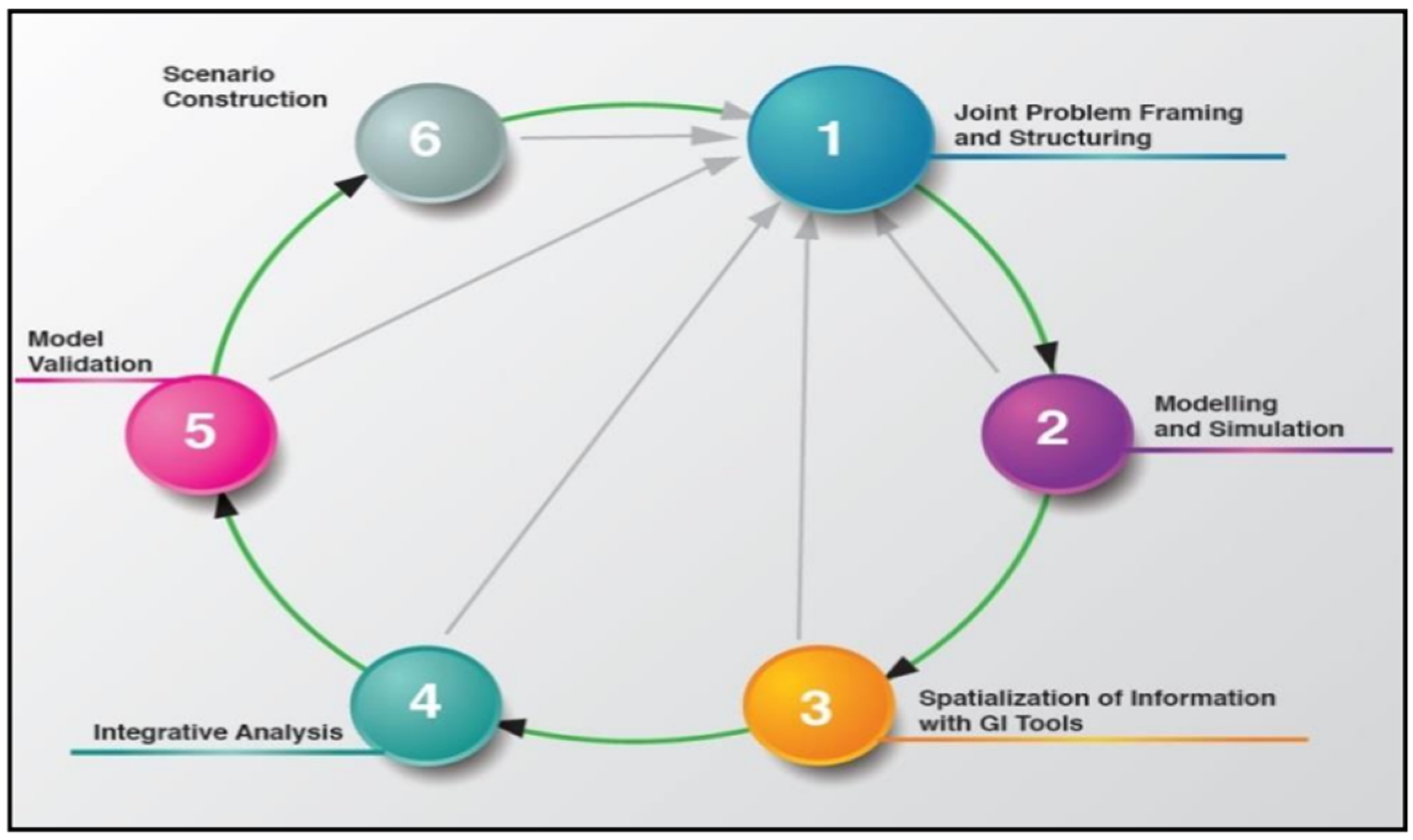
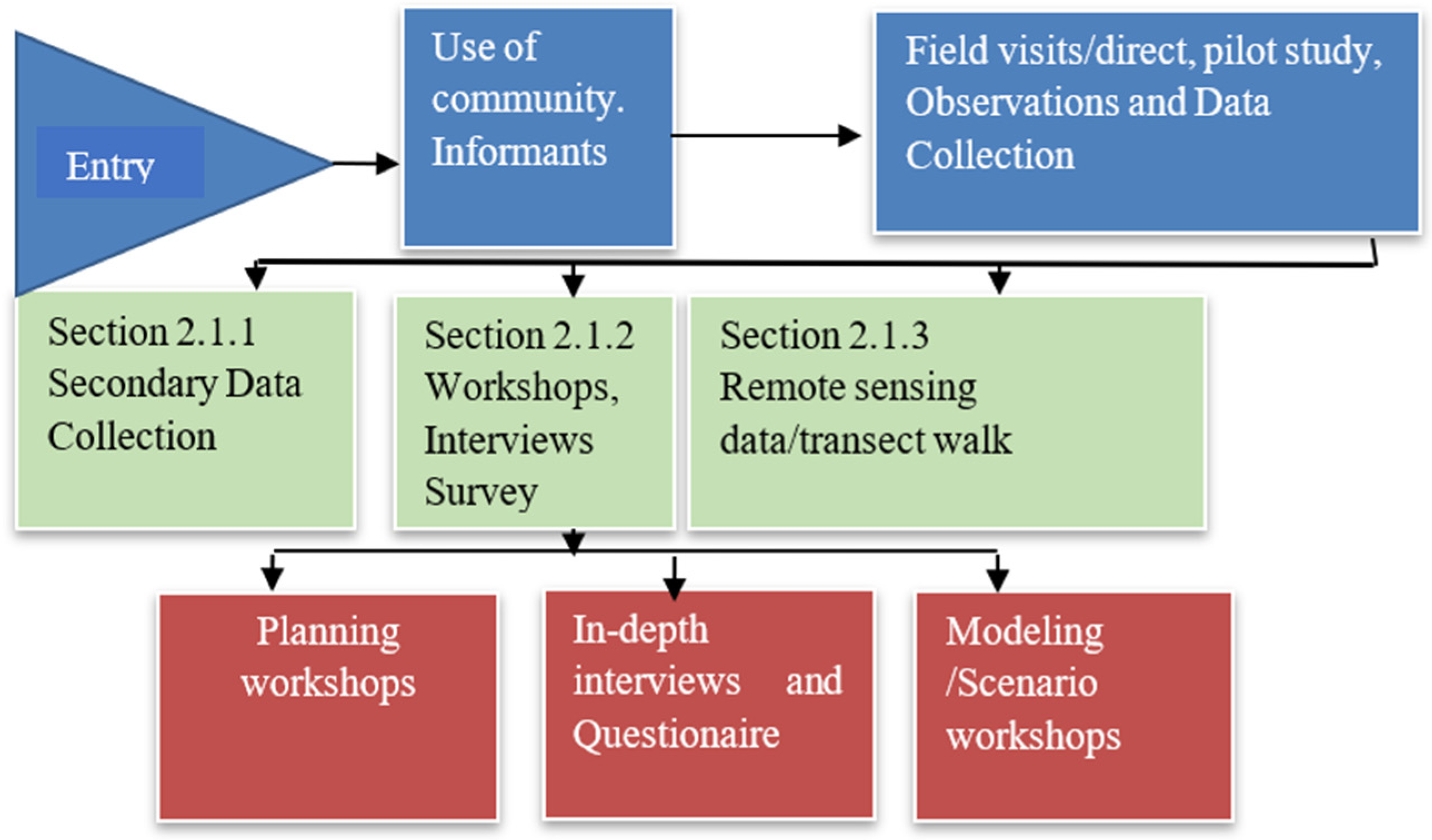
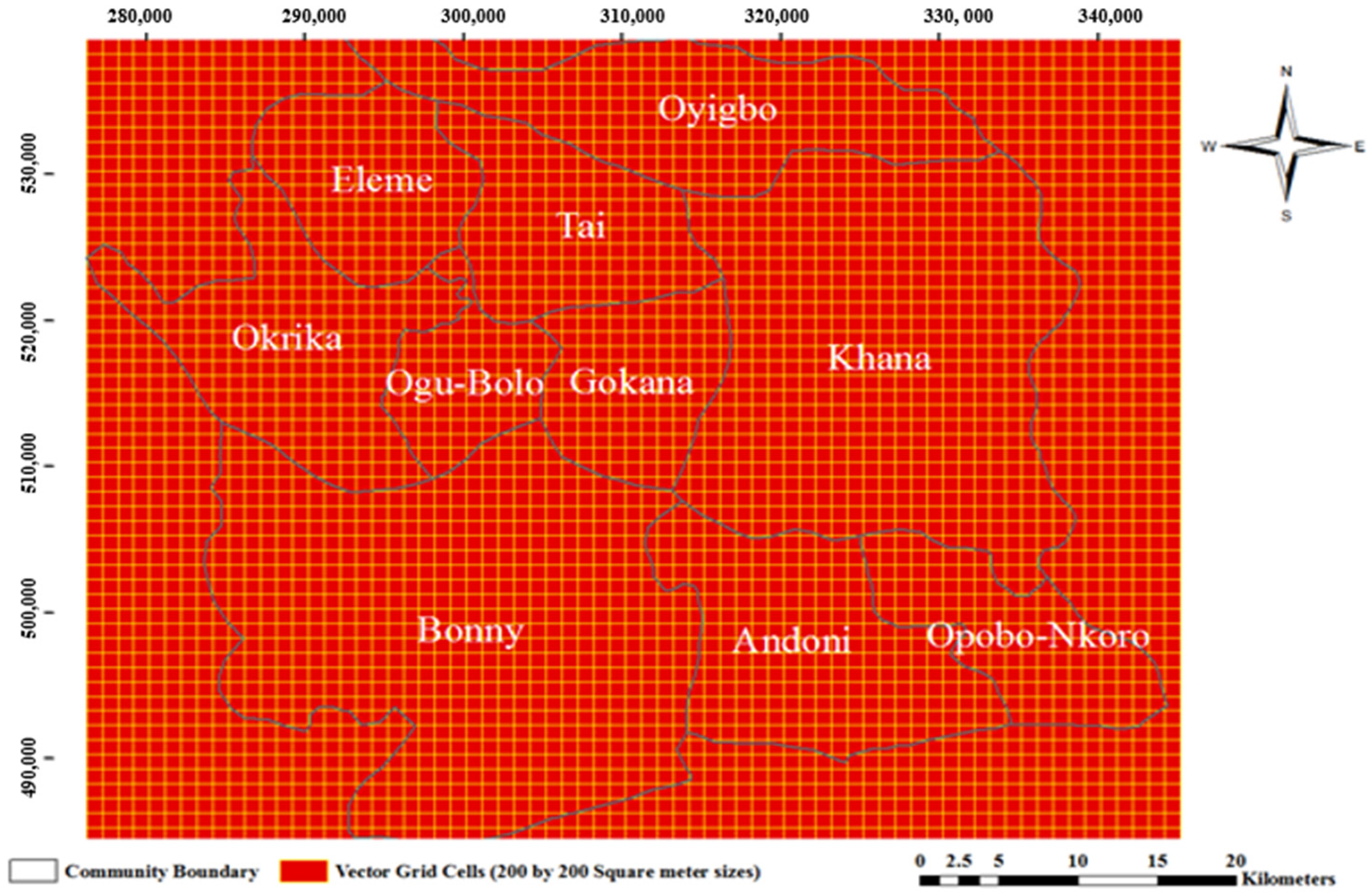
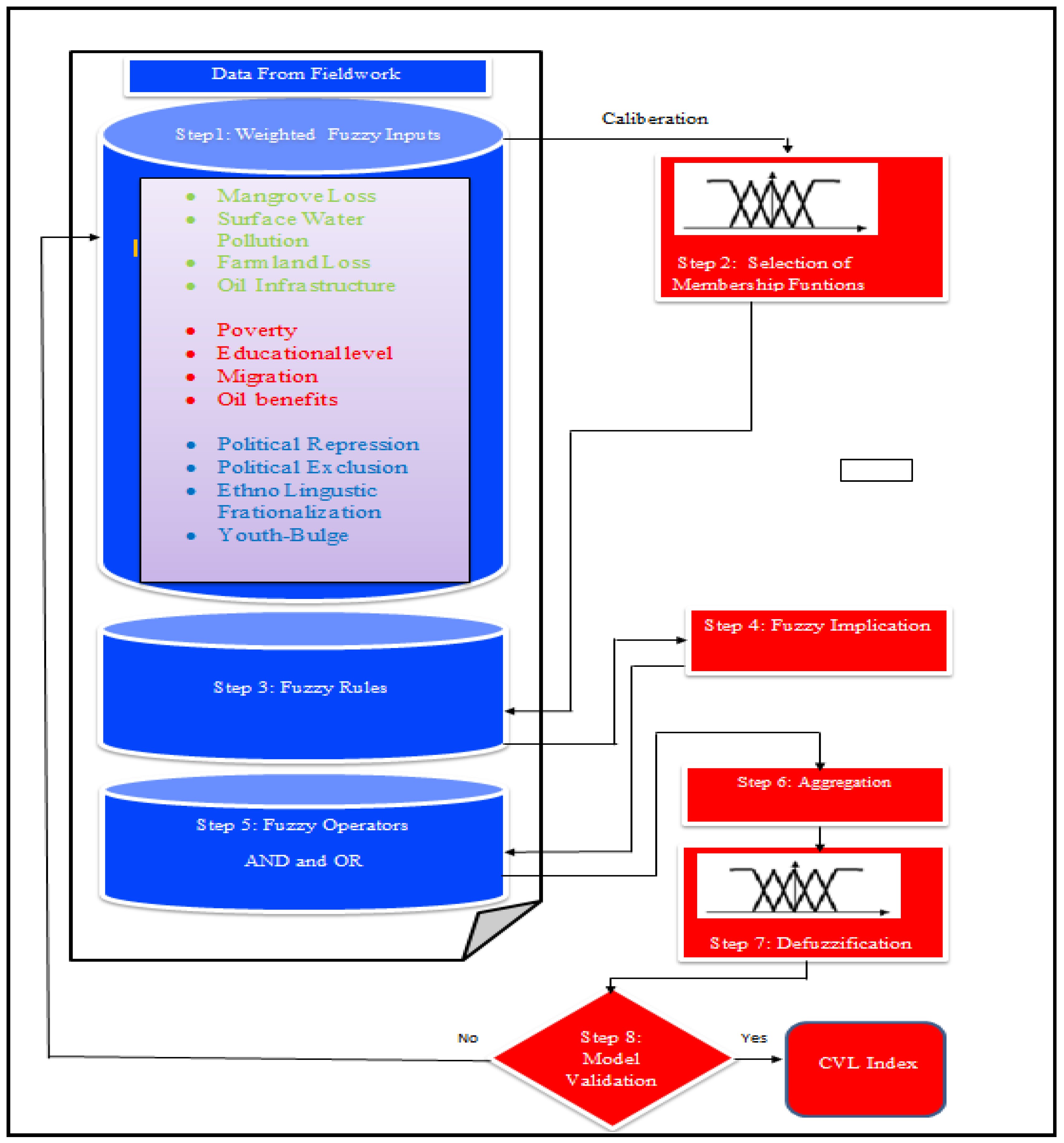
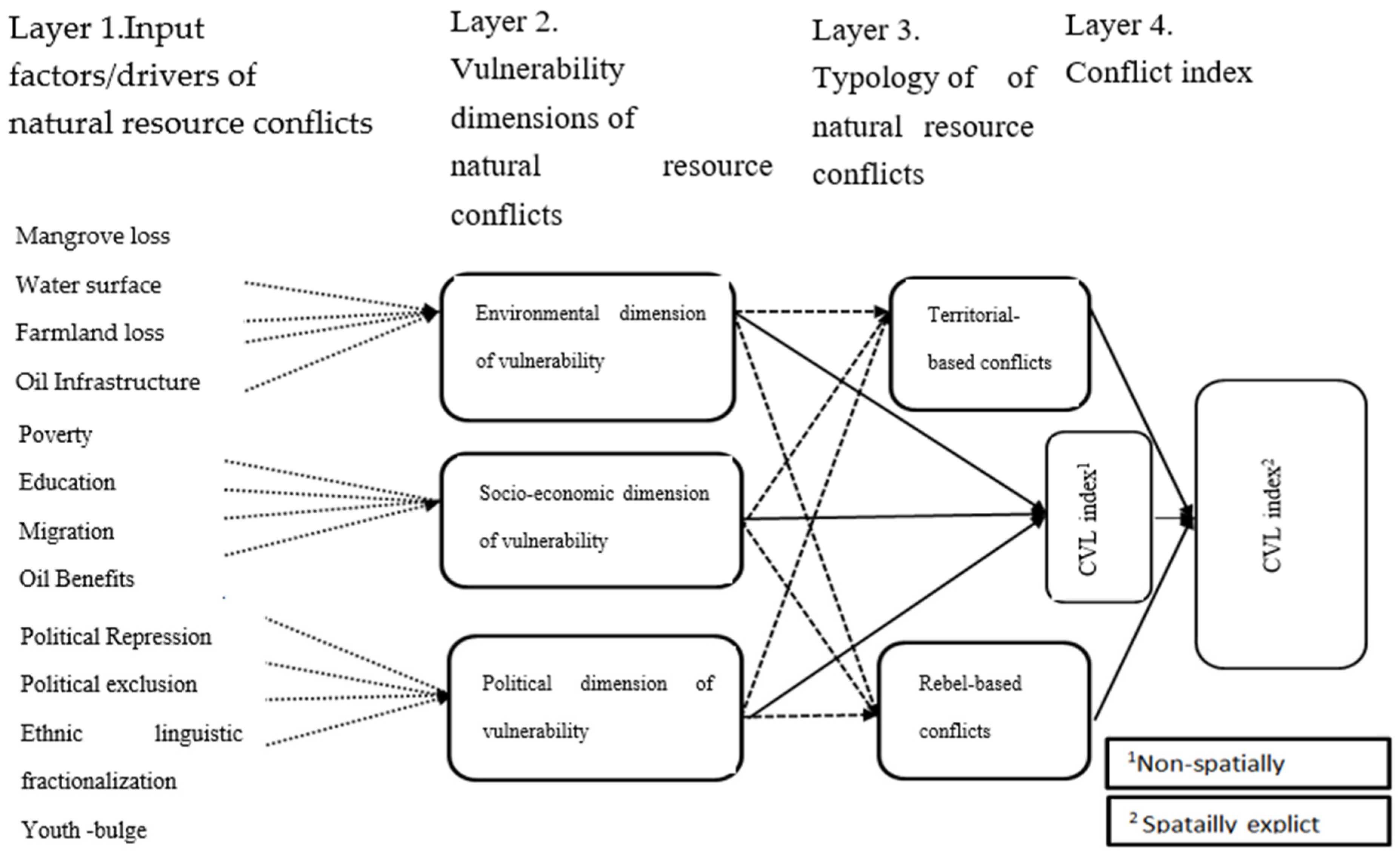
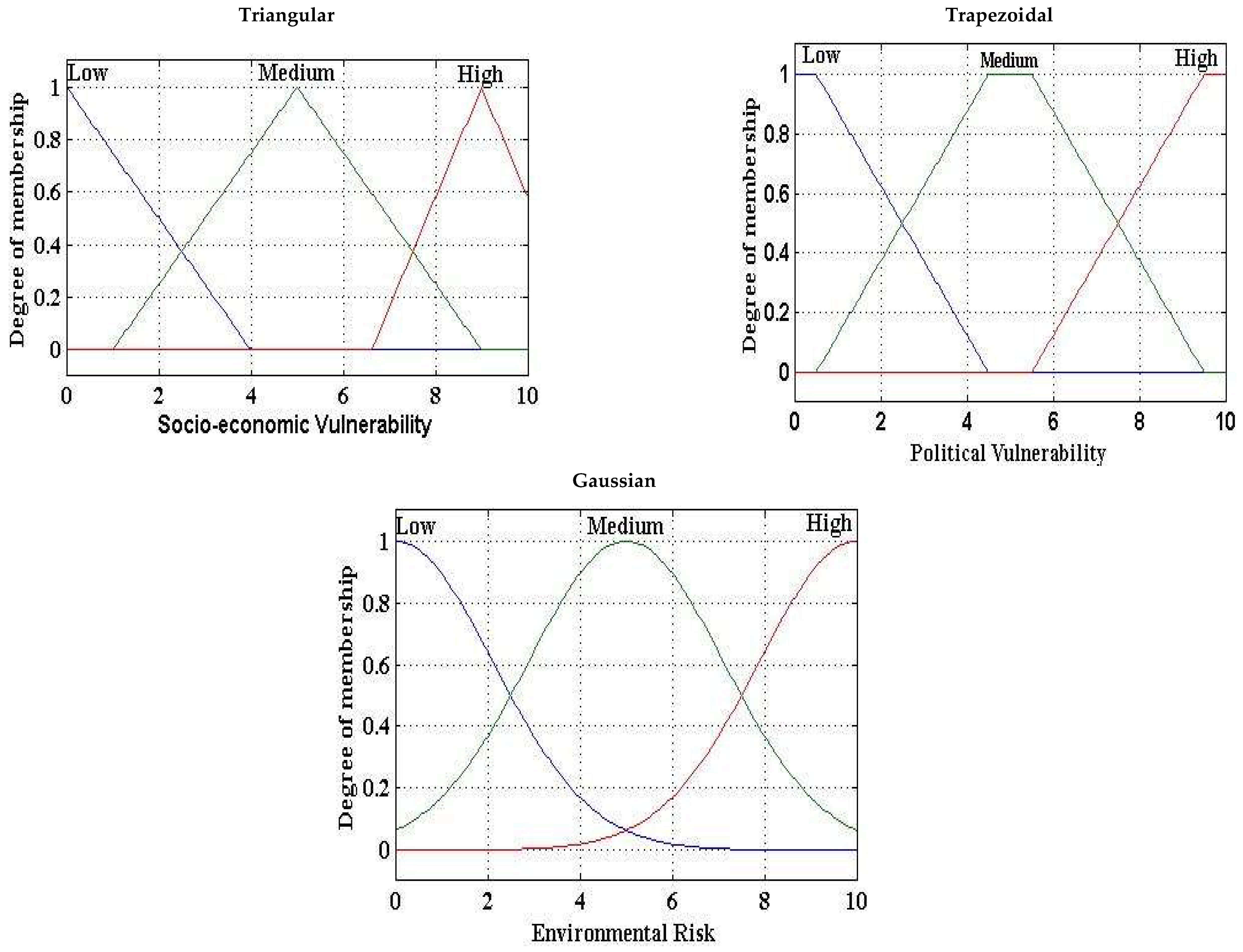
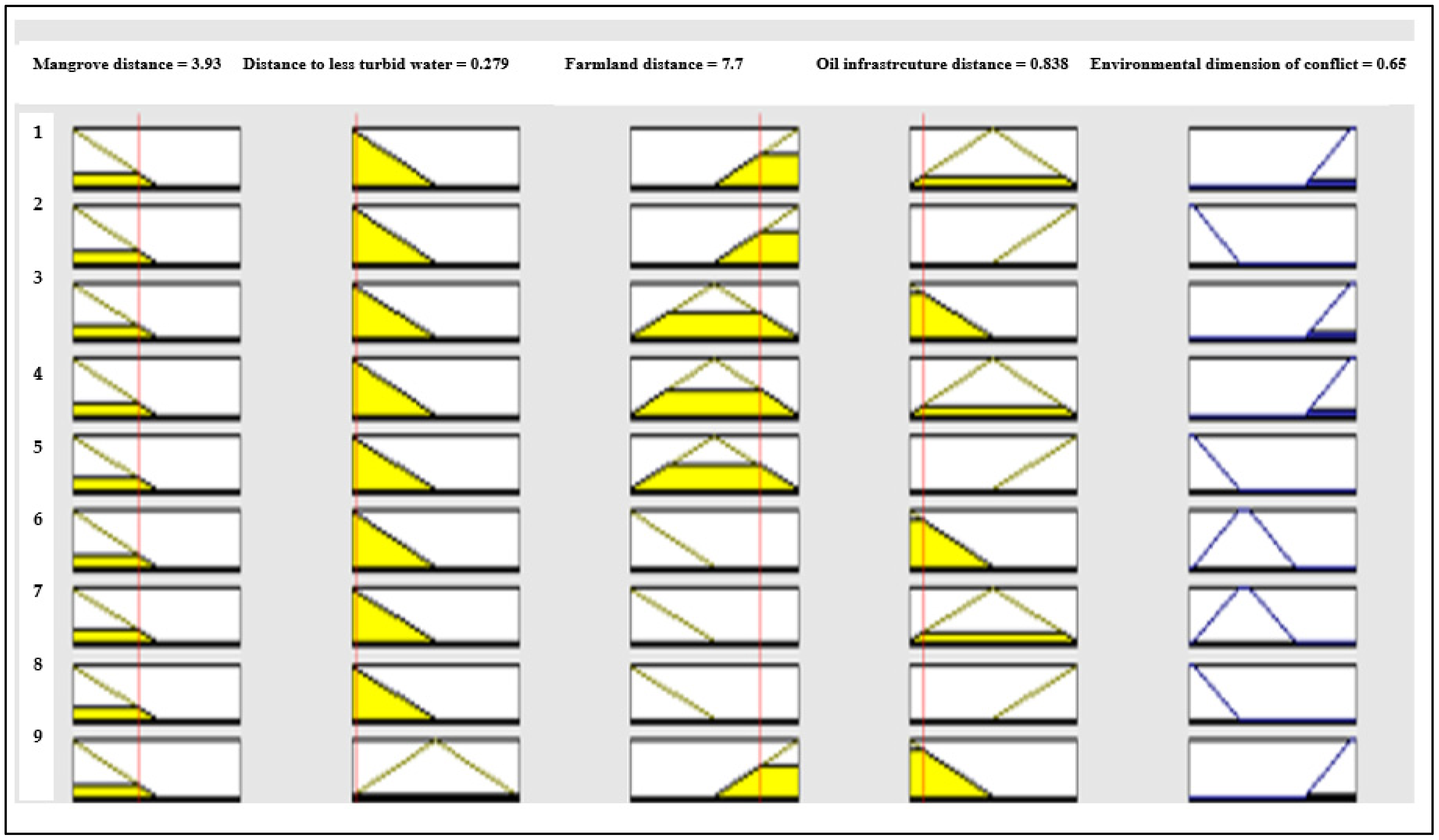
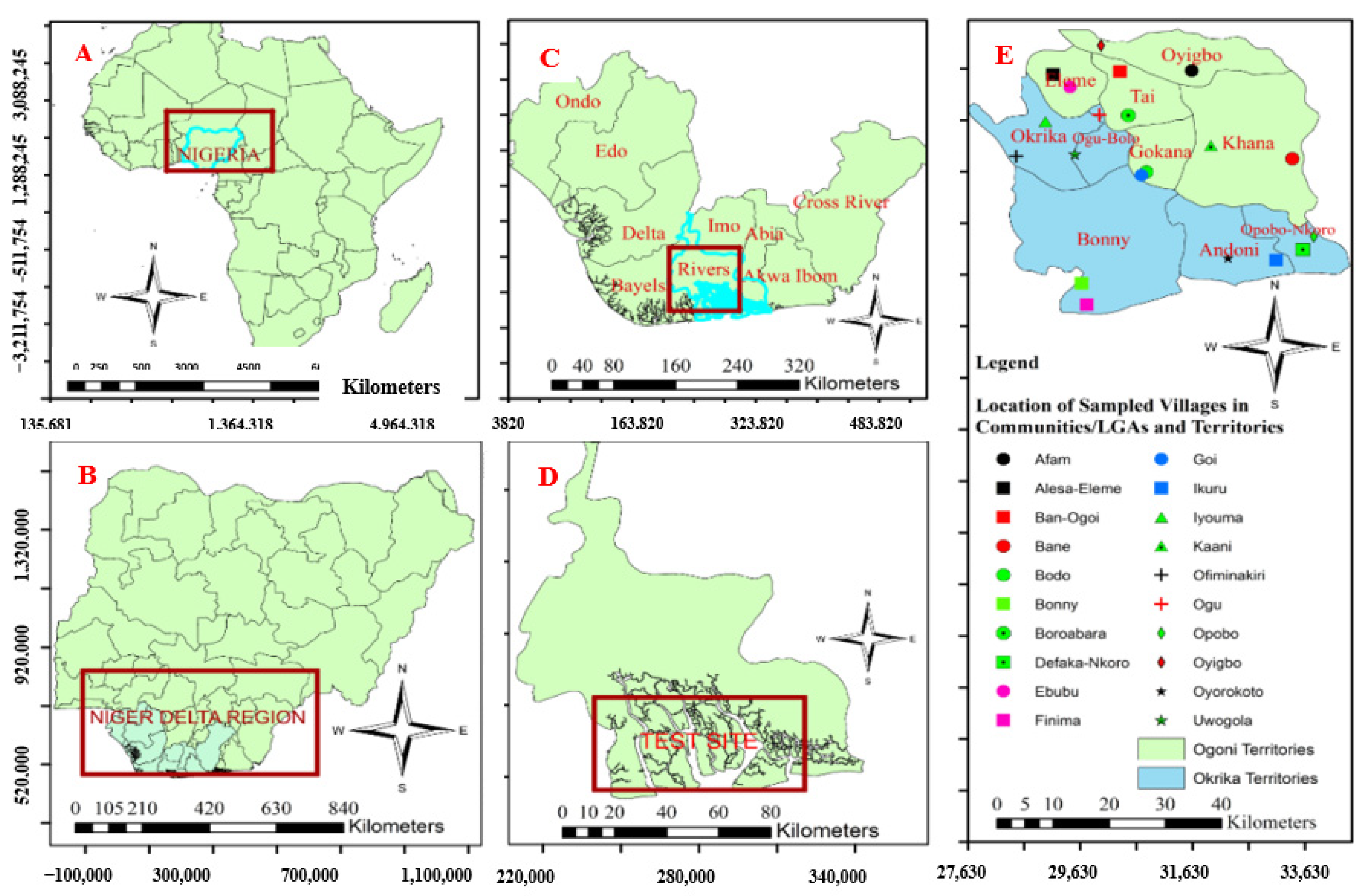
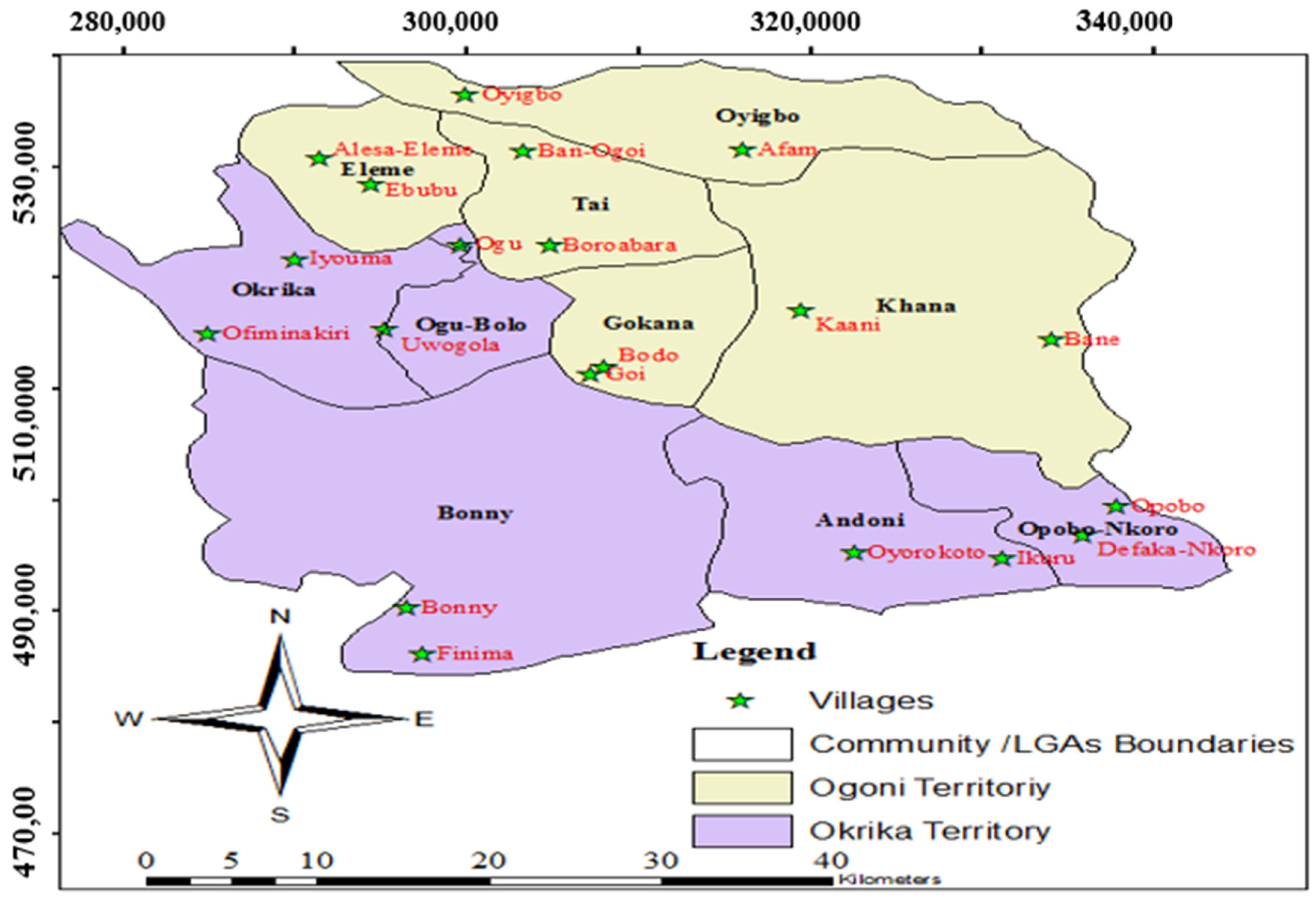
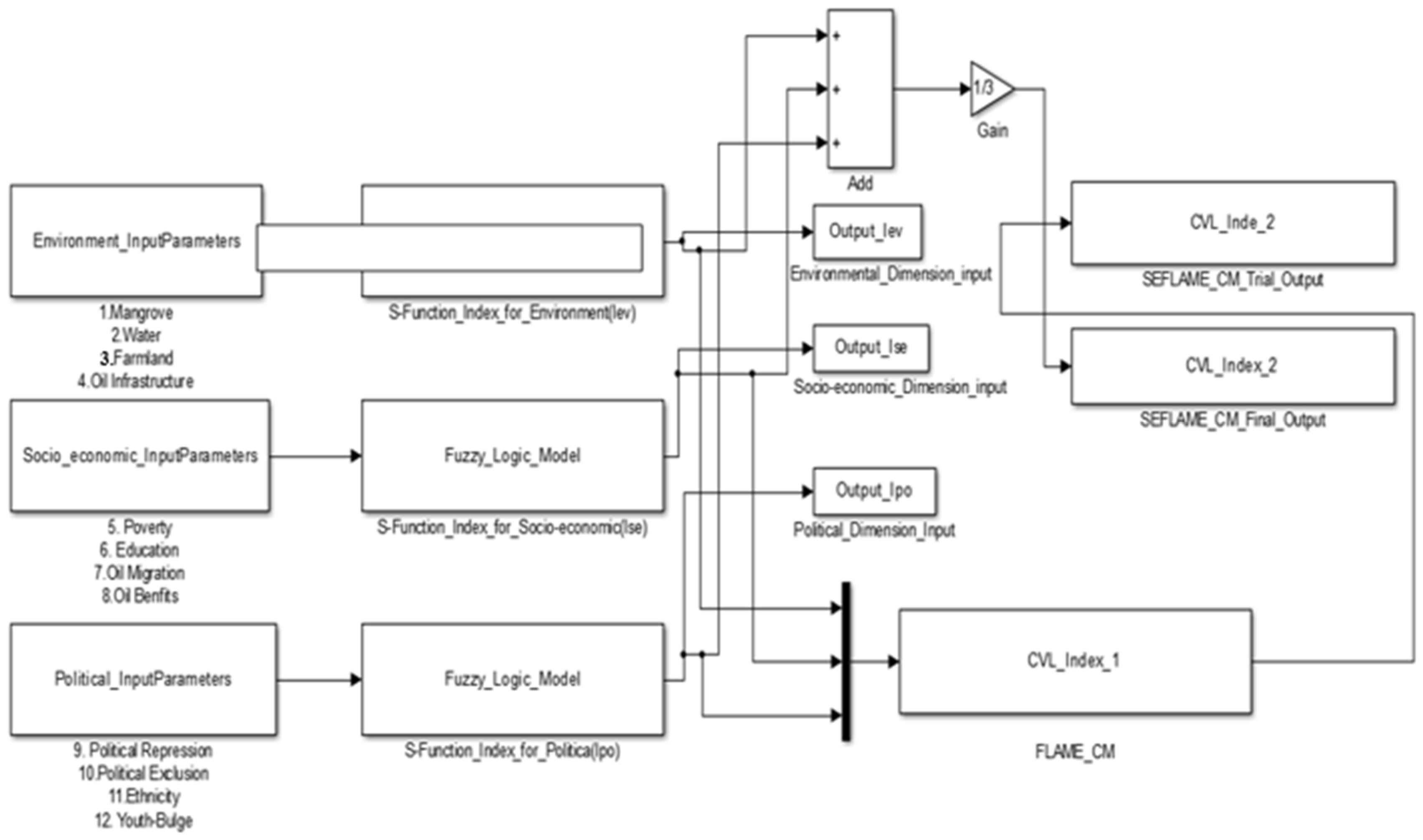
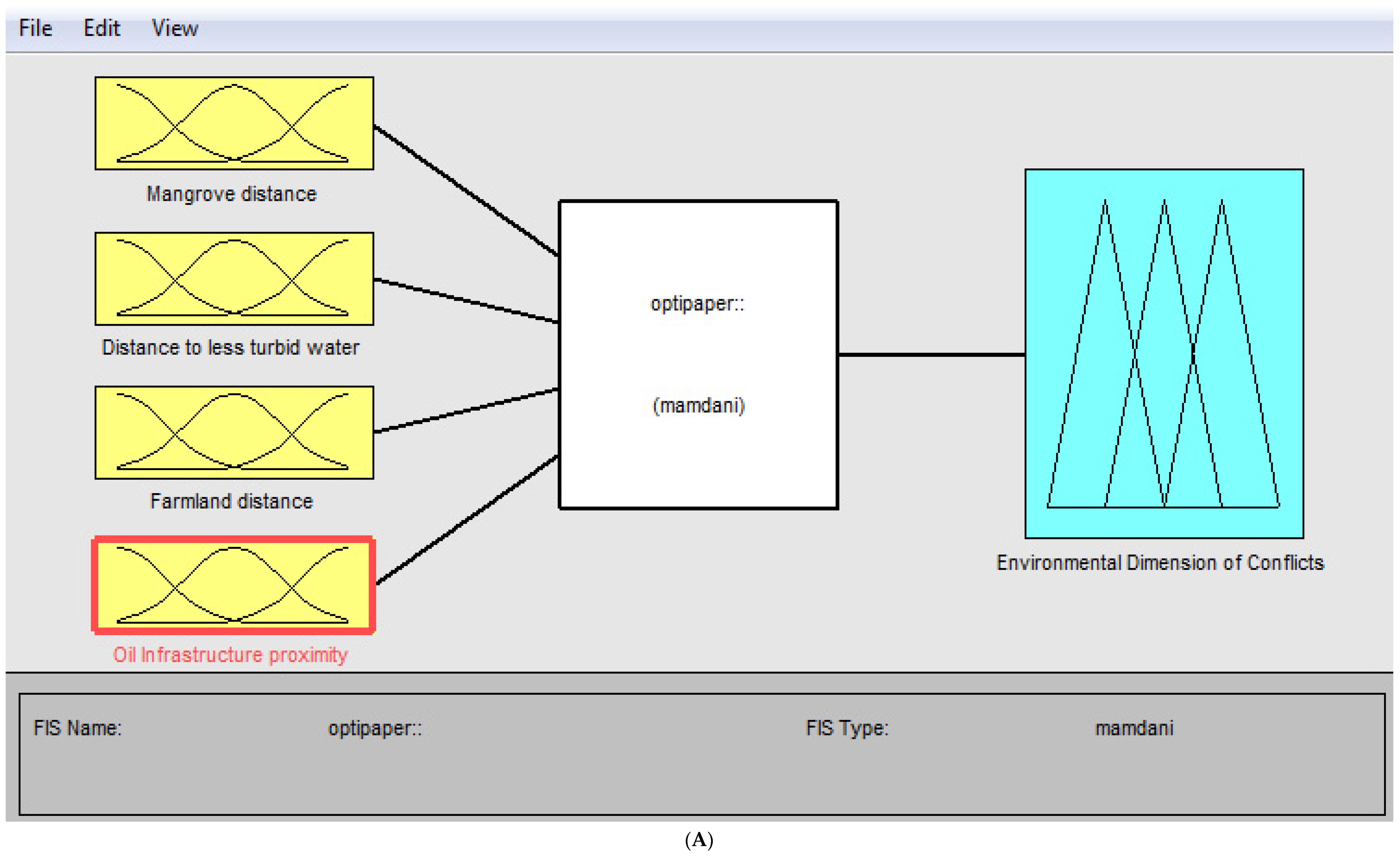
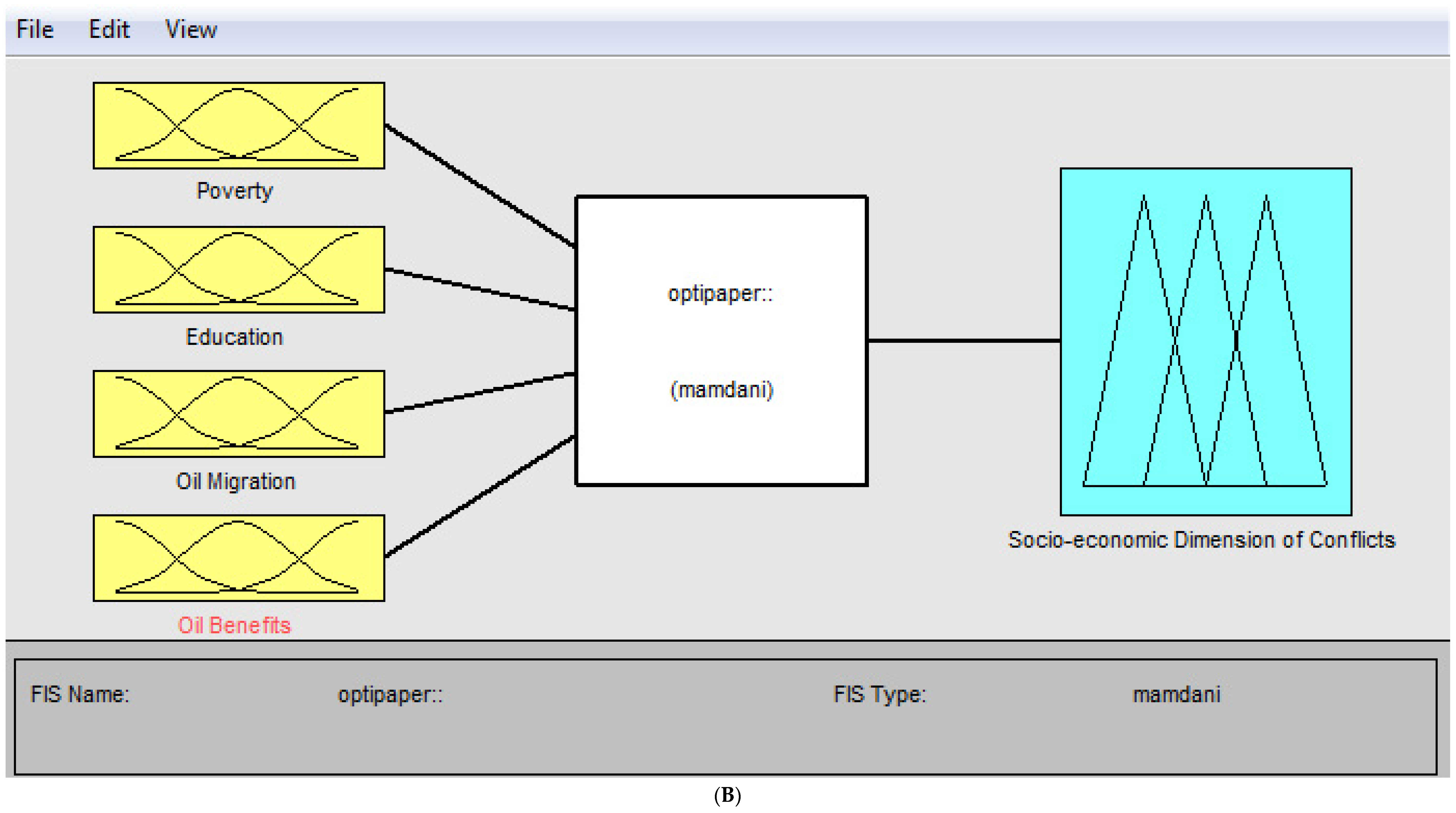
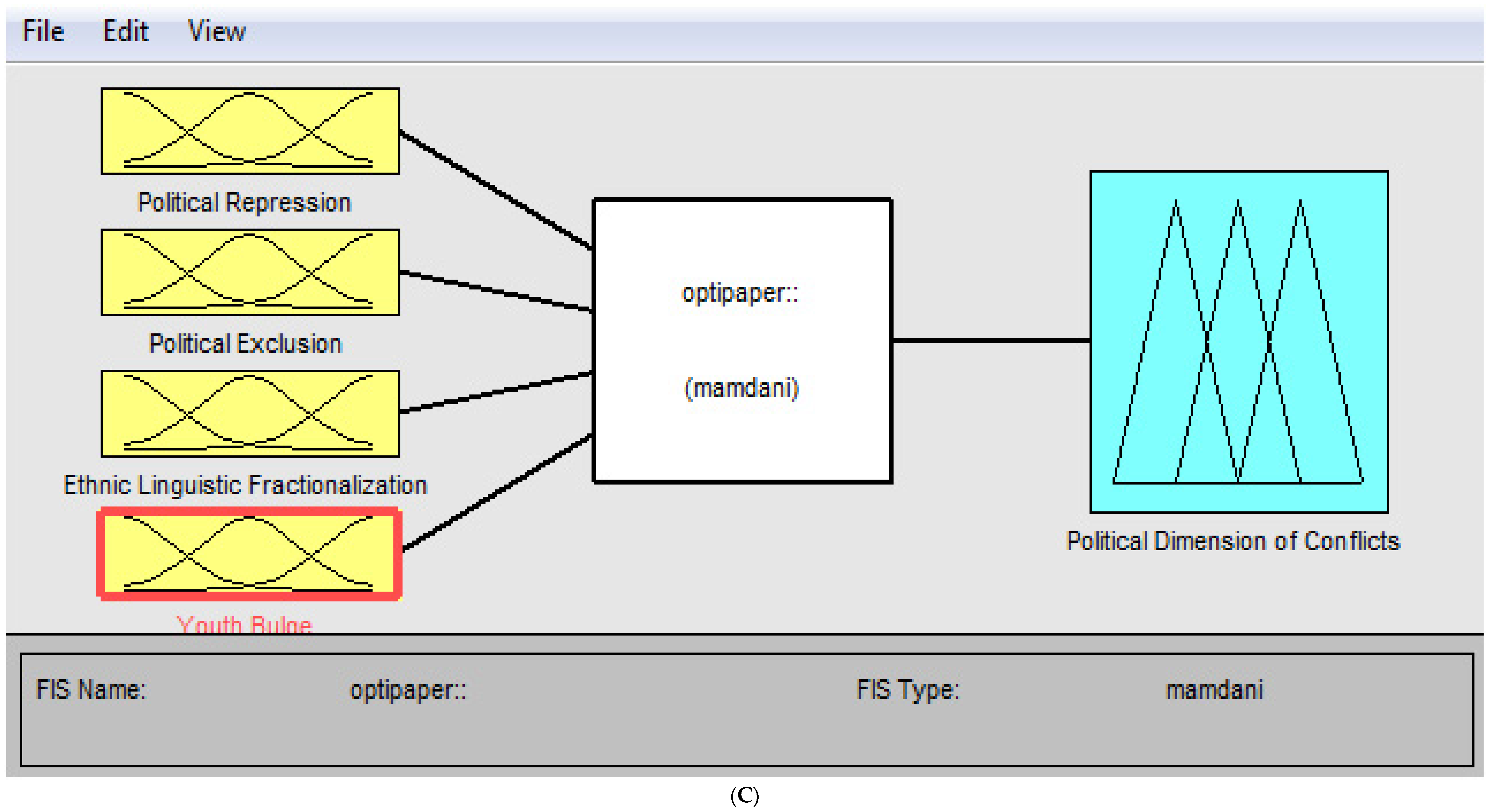
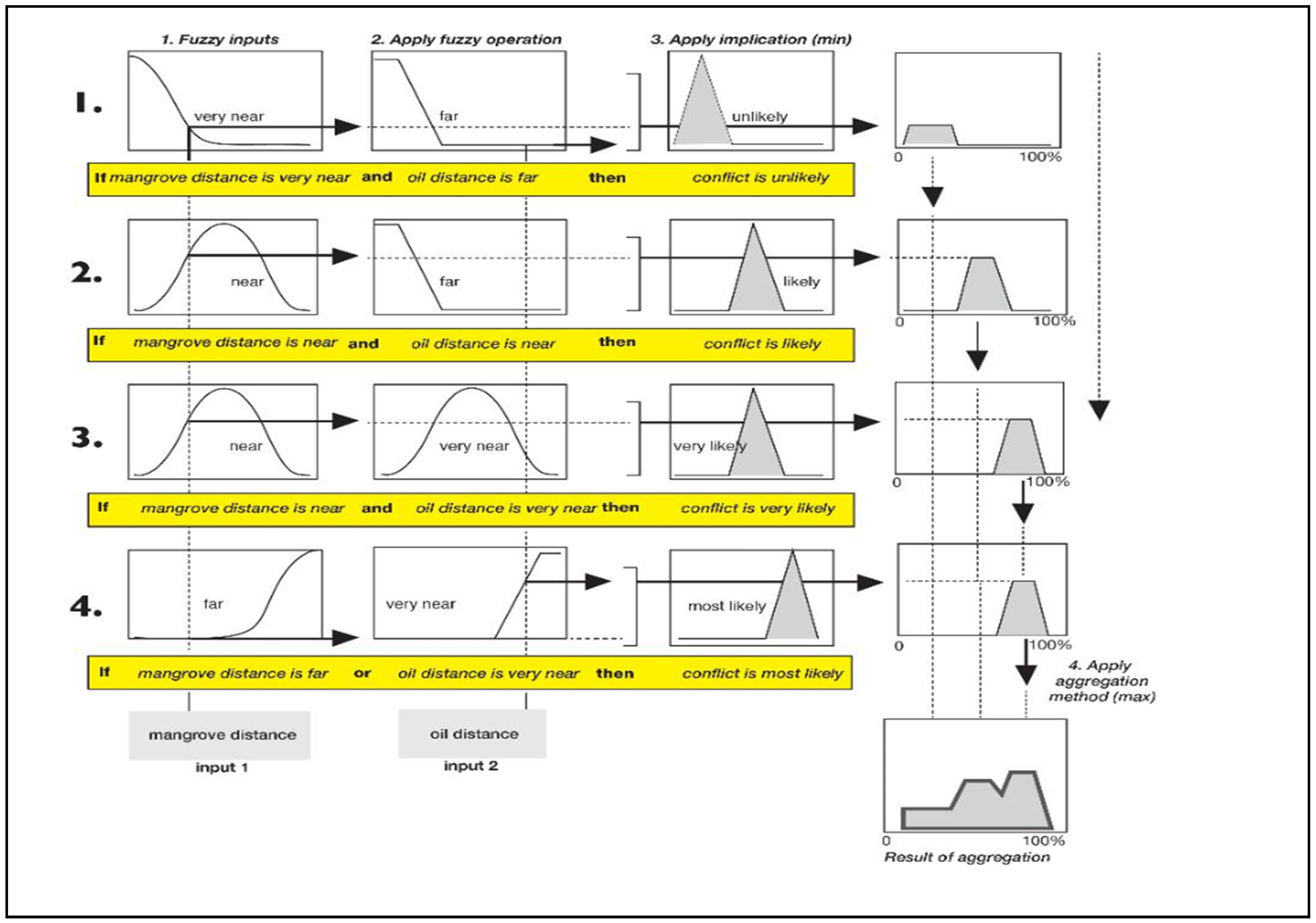
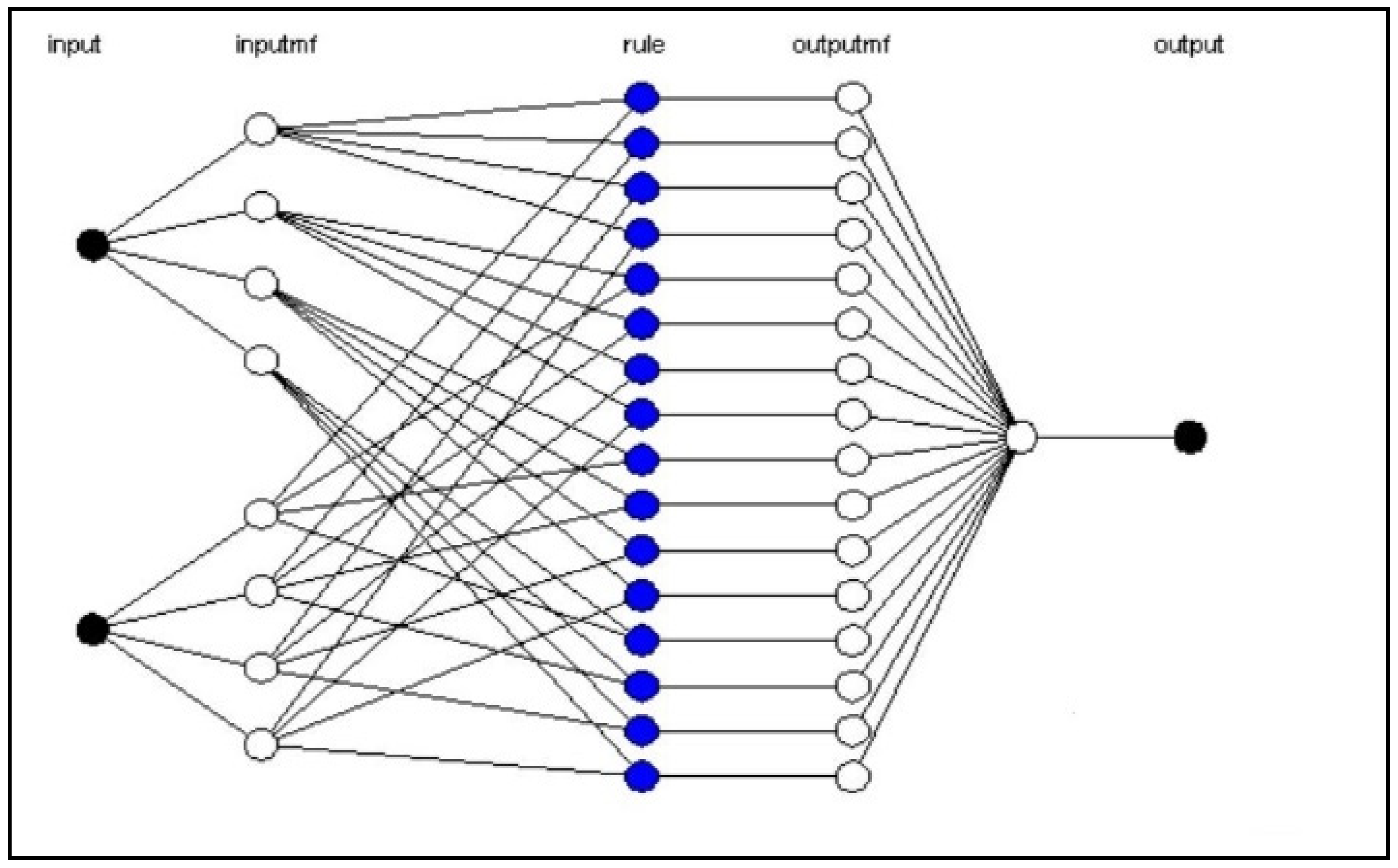
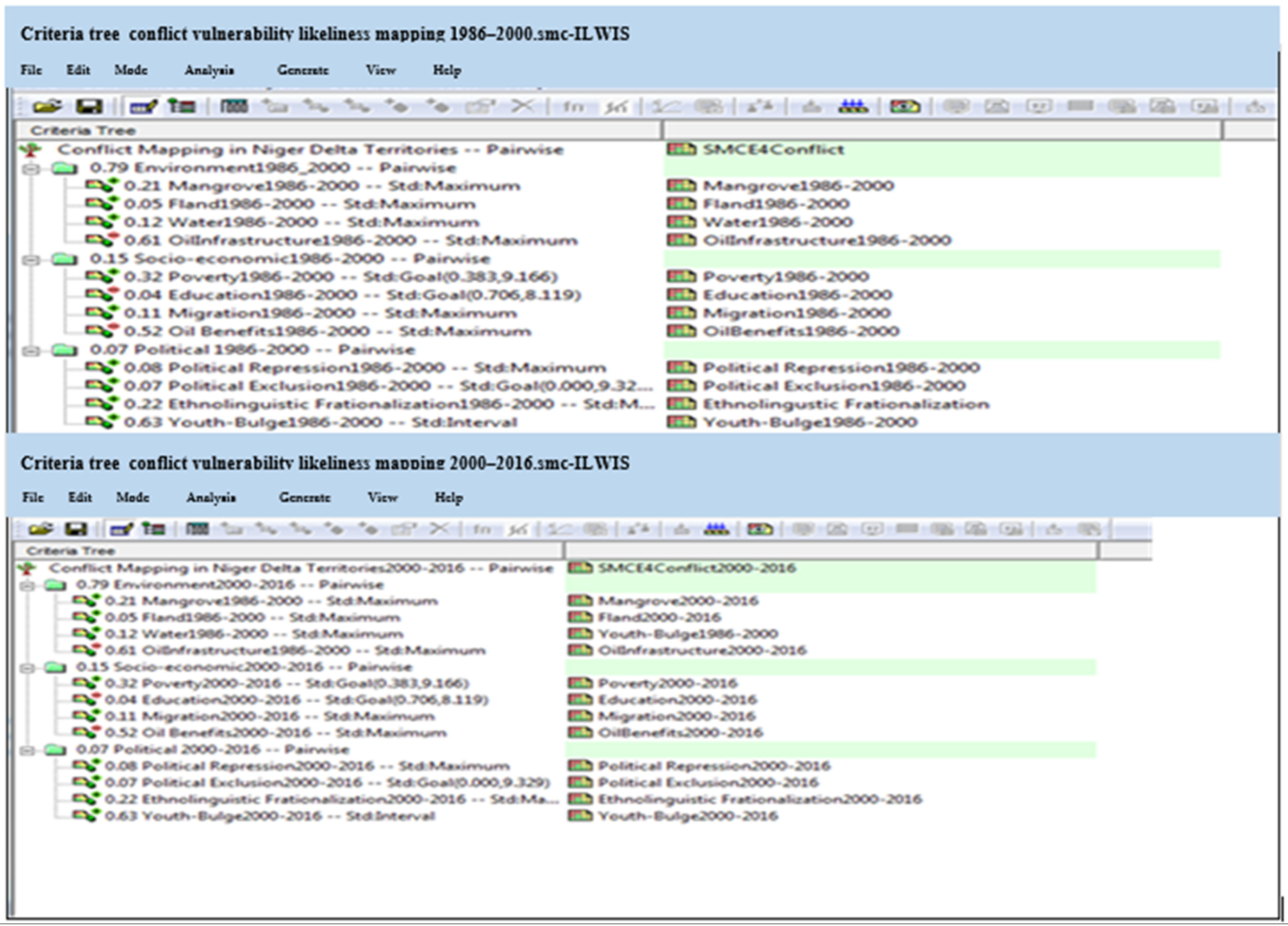
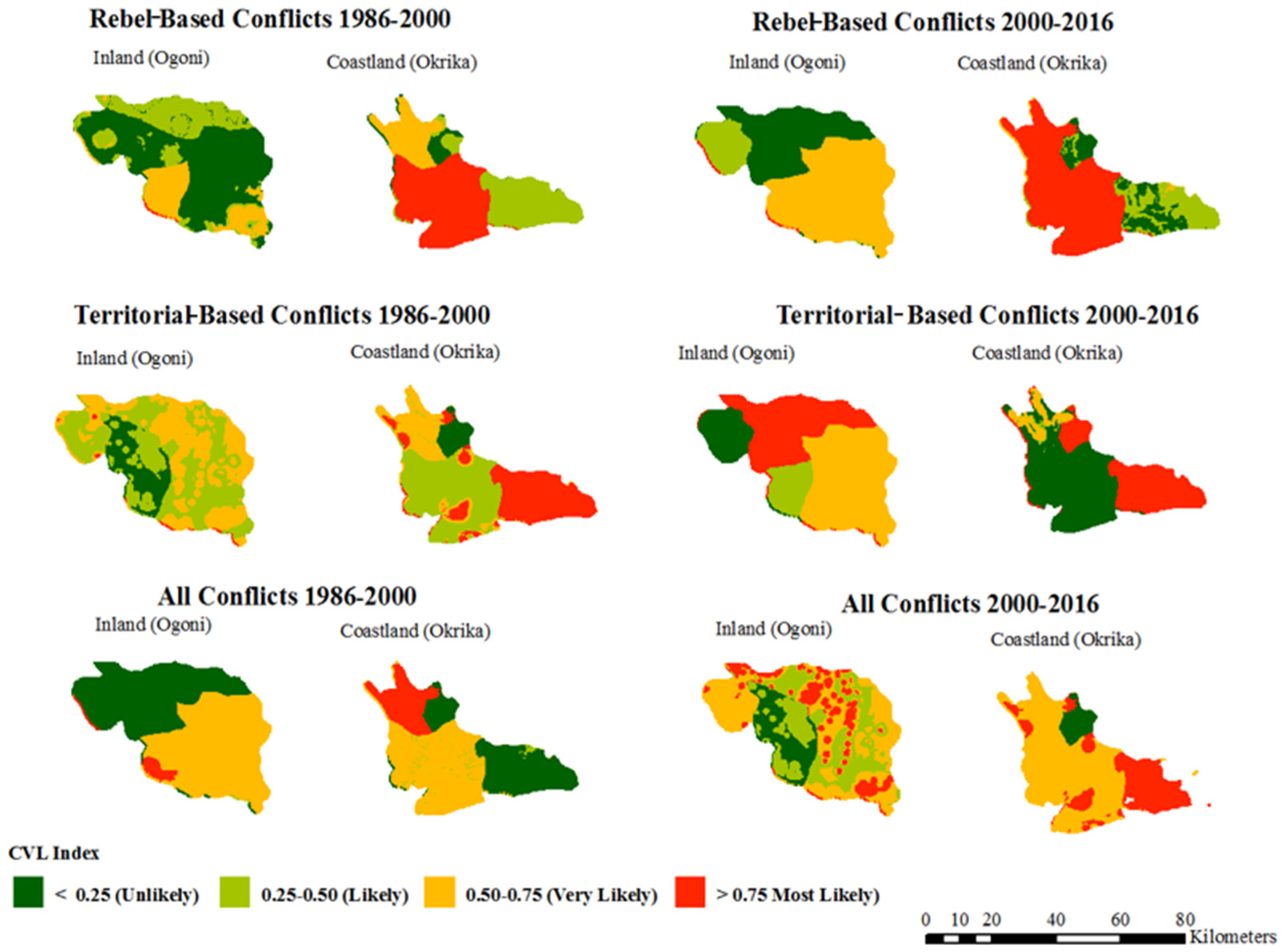
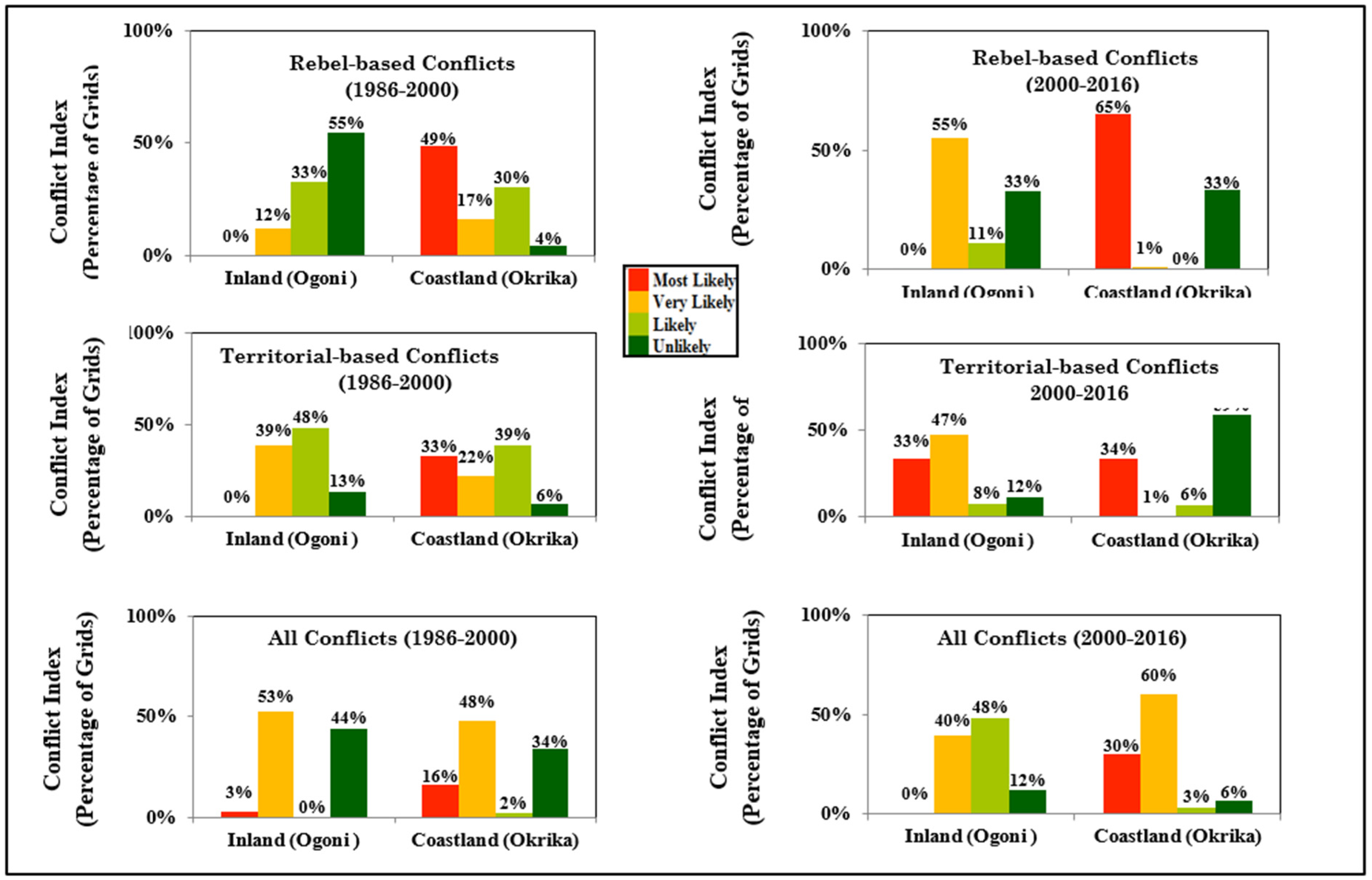
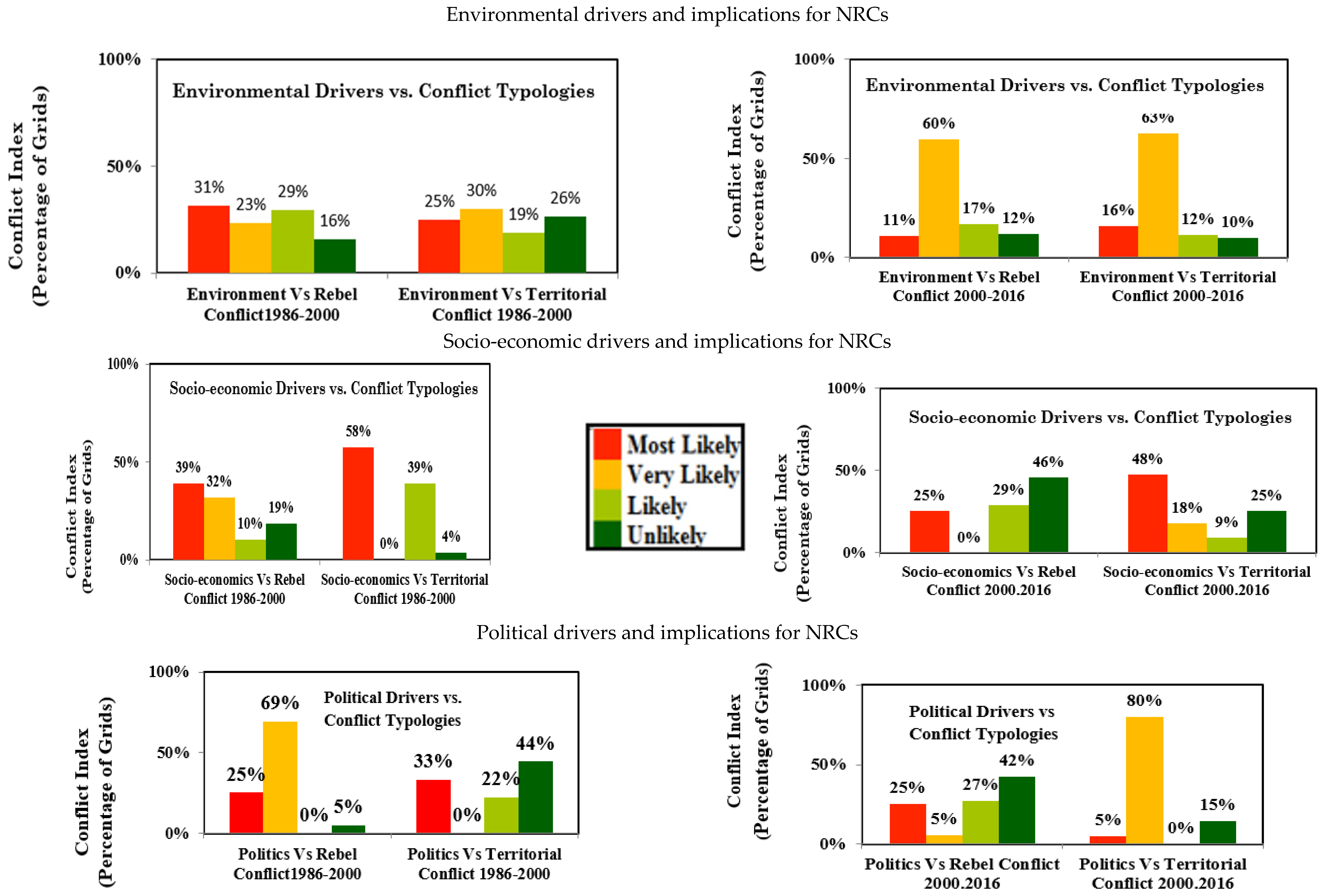
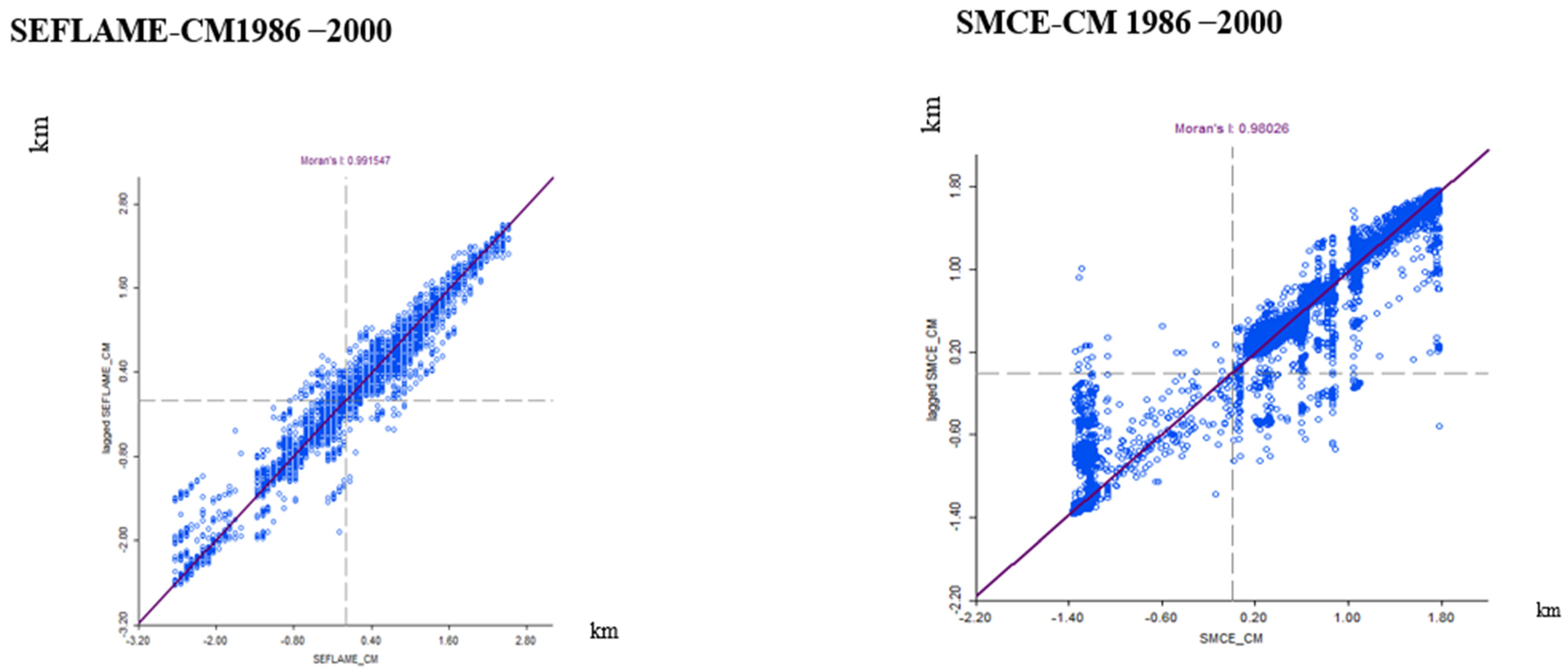
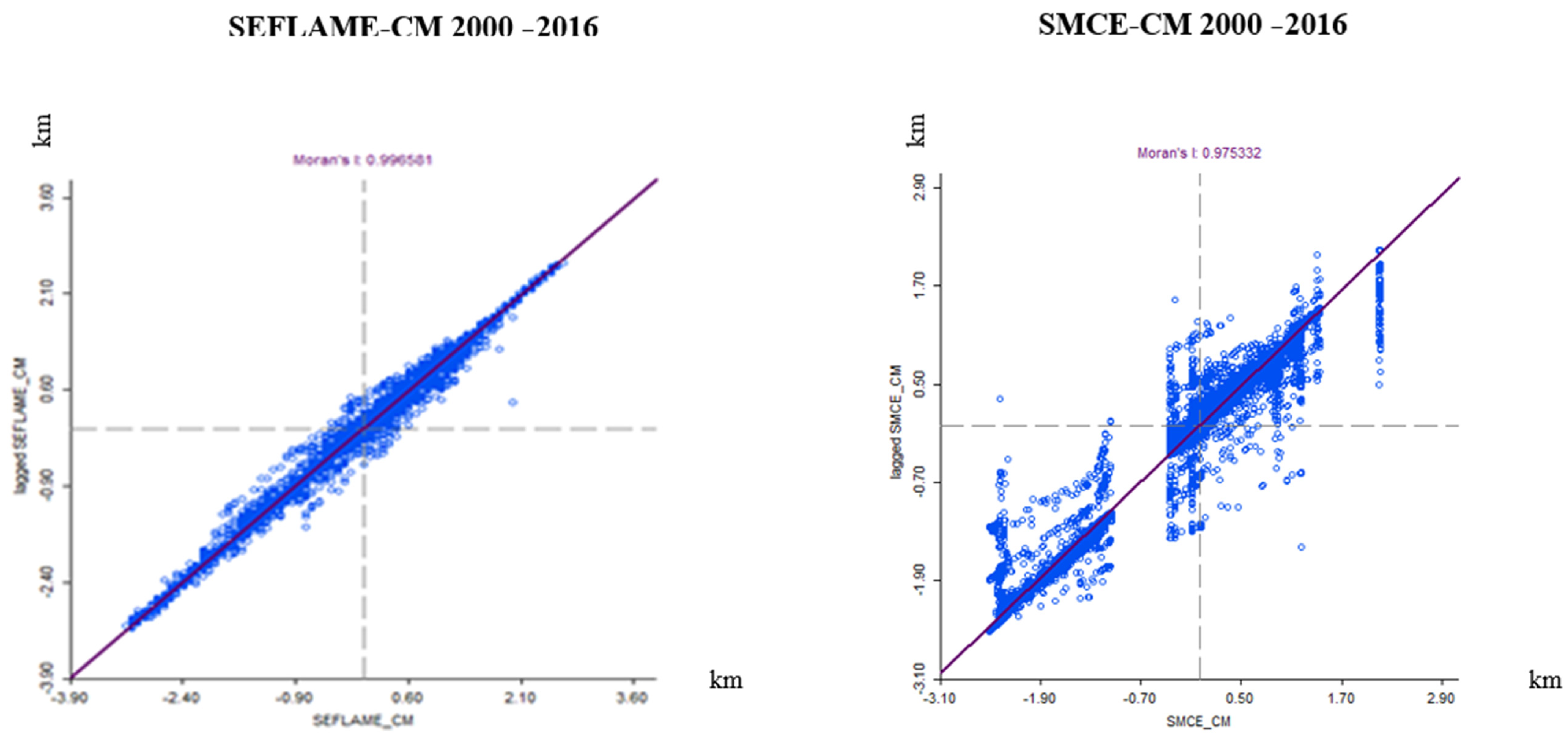
| Conflict Vulnerability Component/ | Conflict Drivers /Factors | Operationalization of SEFLAME-CM Variables | |||
|---|---|---|---|---|---|
| Conflict Indicators (Previous Studies) | Source | Scale | Units (Current Study) | ||
| Environmental risks–exposure to conflicts | Mangrove Loss | % of change of forest | [56] | Large-N | Weighted distance to mangrove forest |
| Log (distance) | [57] | Grid cell | |||
| Farmland loss | Severity of land degradation | [45,56] | Large-N | Weighted distance to farmland | |
| Water | The ratio of (upstream and downstream) | [57] | Grid cell | Weighted distance to less polluted water | |
| Coding of countries crossed with rivers | [58] | Large-N | |||
| Oil infrastructure | % of oil and gas location | [59] | Grid cell | Weighted distance to oil infrastructure | |
| Dist. to oil location | [60] | Grid Cell | |||
| Socio-economic vulnerability to conflicts | Poverty | GDP | [5] | Large-N | weighted % of multidimensional measure of poverty |
| Weighted welfare index (multidimensional poverty) | [61] | Grid cell | |||
| Education level | % male educational level | [62] | Large-N | weighted % of educational level | |
| Migration level | Qualitative Perception of push and pull factors | [63] | Large-N-(selection of cases) National | weighted % of migration level | |
| Oil benefits | % of satisfaction with CSR projects | [64] | Regional | Weighed % of benefits from oil companies in communities | |
| % of acceptance of community reciprocity | [65] | Regional | |||
| Political vulnerability to conflicts | Political repression | Binary measure of perception of repression over the state | [66] | Large-N | Weighted % of perception of community repression |
| Political exclusion | The 5-point scale of ethnic group’s level of exclusion | [67] | National | Weighted % perception of community exclusion | |
| Binary (years of ethnic group exclusion and otherwise) | [68] | Large-N | |||
| Ethnic Ethnolinguistic Fractionalization (ETLF) | Index of ETLF | [69] | Large-N | Weighted % of the Perception of ETlF | |
| Binary (ethnic groups) | [61] | Grid cell | |||
| Youth bulge | % of males within 15–24 year 15–24-year-olds relative to the total adult pop (15 years and above). | [70] | Large-N Large-N | Weighted % of of the influence males between 15–24-years on conflicts | |
| Conflict Drivers and Vulnerability Dimensions | Sources |
|---|---|
| Environmental dimension (external component) | |
| Mangrove loss | Remote sensing |
| Water pollution | Remote sensing |
| Farmland loss | Remote sensing |
| Oil infrastructure, e.g., pipeline, oil well | Petroleum corporations in Nigeria |
| Socio-economic dimension (internal component) | |
| Poverty level (wealth index) | National Population Commission |
| Education level | National Population Commission |
| Oil migration | National Population Commission |
| Oil benefits | National Population Commission |
| Political dimension (internal component) | |
| Political repression | Fieldwork |
| Political exclusion | Fieldwork |
| Ethnic linguistic fractionalization | Census data from National Population Commission/fieldwork |
| Youth bulge | Census data from National Population Commission/fieldwork |
| Observed conflicts | UCDP-GED and ACLED |
| Age | Farmers | Youths | NGOs | Politicians | Community Leaders |
|---|---|---|---|---|---|
| 70 years and above | 40 | 40 | 40 | 40 | 40 |
| 40–69 years | 40 | 40 | 40 | 40 | 40 |
| 20–39 years | 40 | 40 | 40 | 40 | 40 |
| Time Scale | Data | Date | Resolution | Source |
|---|---|---|---|---|
| Before 1986 | Landsat TM | 19 December 1986 | 30 m | USGS |
| 1987–2000 | Landsat ETM | 17 December 2000 | 30 m | USGS |
| 2001–Present | KOMPSAT 2 | 11 February 2012 | 4 m | ESA |
| Nig Sat 2 | 11 February 2013 | 22 m | NSRDA | |
| Landsat 8 | 3 January 2016 | 30 m | USGS |
| Level I (Main Cover Category) | Code * | Level II (Category Description) |
|---|---|---|
| Built-up | BU | Single-family Units, Multi-family, Group Quarters, Other Residential or industrial infrastructures |
| Farmland | FL | Cropland, Mixed farmland, plantations, and others |
| Water Pollution | WP | Streams, canals, lakes, bays, and estuaries |
| Mangrove Loss | ML | Mangrove swamp forest, different mangrove trees, and shrubs, mangrove trenches |
| Secondary Forest | SF | Disturbed thick forest, abandoned farmlands |
| Thick forest | TF | Undisturbed forests such as nypa palm |
| Distance | Mangrove (ha) | Farmland (ha) | Water (ha) |
|---|---|---|---|
| Very Near | 0–5 km | 0–5 km | 0–5 km |
| Near | 5–10 km | 5–10 km | 5–10 km |
| Far | 10–15 km | 10–15 km | 10–15 km |
| Input Variables | Fuzzy set Parameter (Categories) |
|---|---|
| Mangrove Distance | Verynear (1)-Near (2)-Far (3) |
| Distance to Less Turbid water | Verynear (2)-Near (2)-Far (3) |
| Distance to Farmland | Verynear (1)-Near (2)-Far (3) |
| Oil Infrastructure Distance | Verynear (1)-Near (2)-Far (3) |
| Poverty | High (1)-Medium (2)-Low (3) |
| Education | High (1)-Medium (2)-Low (3) |
| Oil Migration | High (1)-Medium (2)-Low (3) |
| Oil Benefits | High (1)-Medium (2)-Low (3) |
| Political Repression | High (1)-Medium (2)-Low (3) |
| Political Exclusion | High (1)-Medium (2)-Low (3) |
| Ethnic Linguistic Fractionalization | High (1)-Medium (2)-Low (3) |
| Youth-Bulge | High (1)-Medium (2)-Low (3) |
| Output | Fuzzy Set of Conflict Likeliness |
|---|---|
| Environmental risk Vulnerability | Unlikely-Likely-Very Likely-Most Likely |
| Socio-economic Vulnerability | Unlikely-Likely-Very Likely-Most Likely |
| Political Vulnerability | Unlikely-Likely-Very Likely-Most Likely |
| CVL Index | Unlikely-Likely-Very Likely-Most Likely |
Disclaimer/Publisher’s Note: The statements, opinions and data contained in all publications are solely those of the individual author(s) and contributor(s) and not of MDPI and/or the editor(s). MDPI and/or the editor(s) disclaim responsibility for any injury to people or property resulting from any ideas, methods, instructions or products referred to in the content. |
© 2025 by the authors. Licensee MDPI, Basel, Switzerland. This article is an open access article distributed under the terms and conditions of the Creative Commons Attribution (CC BY) license (https://creativecommons.org/licenses/by/4.0/).
Share and Cite
Ibeh, L.; Kouveliotis, K.; Unune, D.R.; Cuong, N.M.; Mutai, N.; Fountis, A.; Samoylenko, S.; Pattanaik, P.; Kumari, S.; Sambiri, B.B.; et al. A Novel Approach to Integrating Community Knowledge into Fuzzy Logic-Adapted Spatial Modeling in the Analysis of Natural Resource Conflicts. Sustainability 2025, 17, 2315. https://doi.org/10.3390/su17052315
Ibeh L, Kouveliotis K, Unune DR, Cuong NM, Mutai N, Fountis A, Samoylenko S, Pattanaik P, Kumari S, Sambiri BB, et al. A Novel Approach to Integrating Community Knowledge into Fuzzy Logic-Adapted Spatial Modeling in the Analysis of Natural Resource Conflicts. Sustainability. 2025; 17(5):2315. https://doi.org/10.3390/su17052315
Chicago/Turabian StyleIbeh, Lawrence, Kyriakos Kouveliotis, Deepak Rajendra Unune, Nguyen Manh Cuong, Noah Mutai, Anastasios Fountis, Svitlana Samoylenko, Priyadarshini Pattanaik, Sushma Kumari, Benjamin Bensam Sambiri, and et al. 2025. "A Novel Approach to Integrating Community Knowledge into Fuzzy Logic-Adapted Spatial Modeling in the Analysis of Natural Resource Conflicts" Sustainability 17, no. 5: 2315. https://doi.org/10.3390/su17052315
APA StyleIbeh, L., Kouveliotis, K., Unune, D. R., Cuong, N. M., Mutai, N., Fountis, A., Samoylenko, S., Pattanaik, P., Kumari, S., Sambiri, B. B., Mohamud, S., & Baskakova, A. (2025). A Novel Approach to Integrating Community Knowledge into Fuzzy Logic-Adapted Spatial Modeling in the Analysis of Natural Resource Conflicts. Sustainability, 17(5), 2315. https://doi.org/10.3390/su17052315








